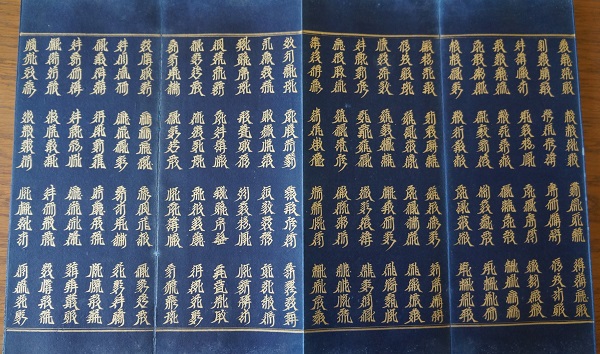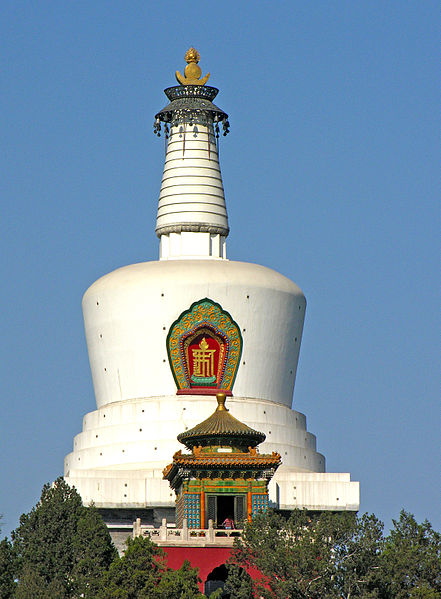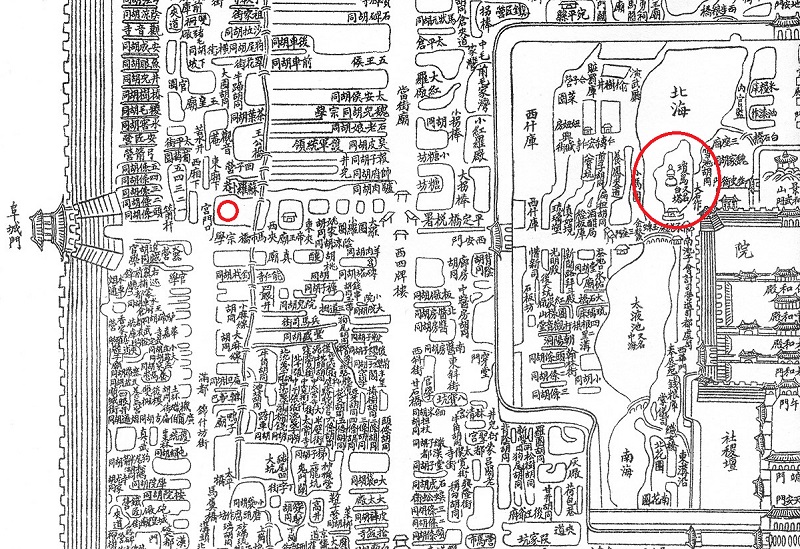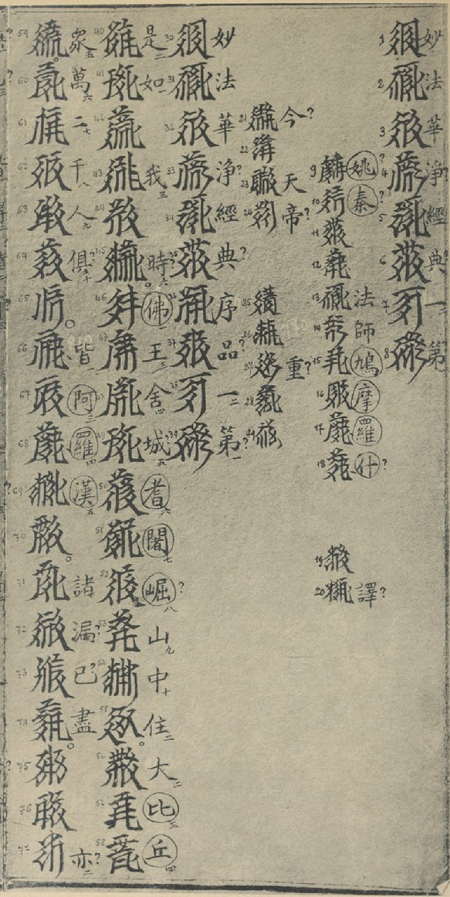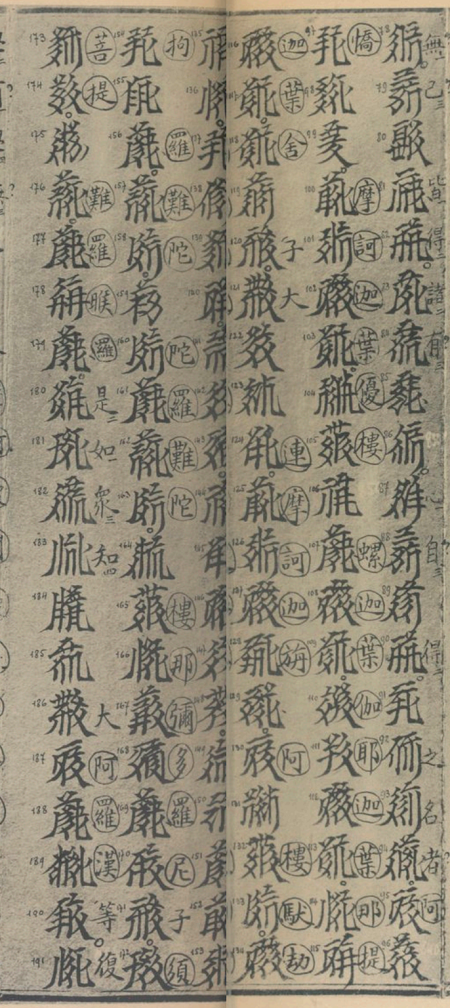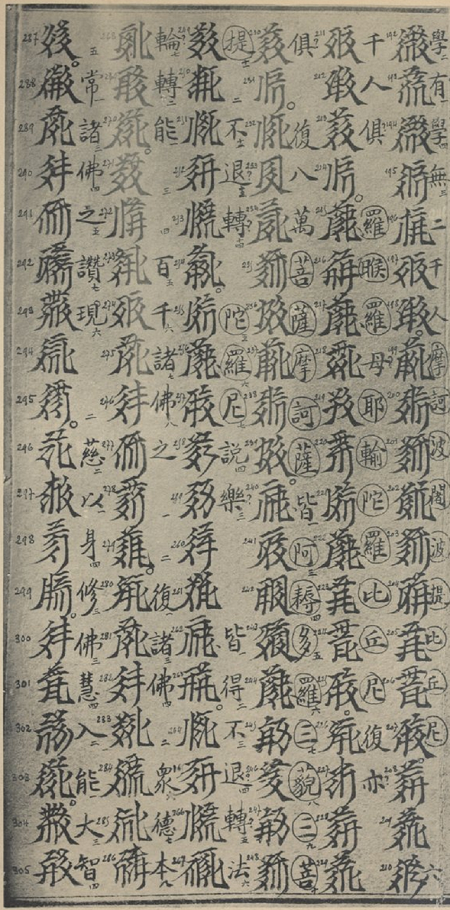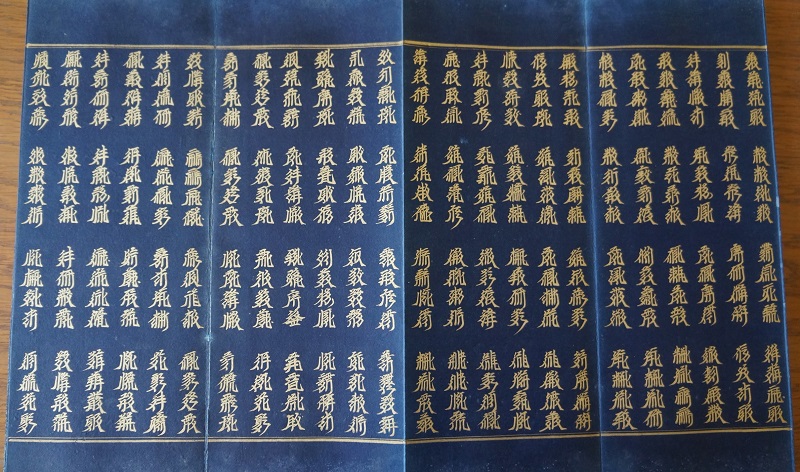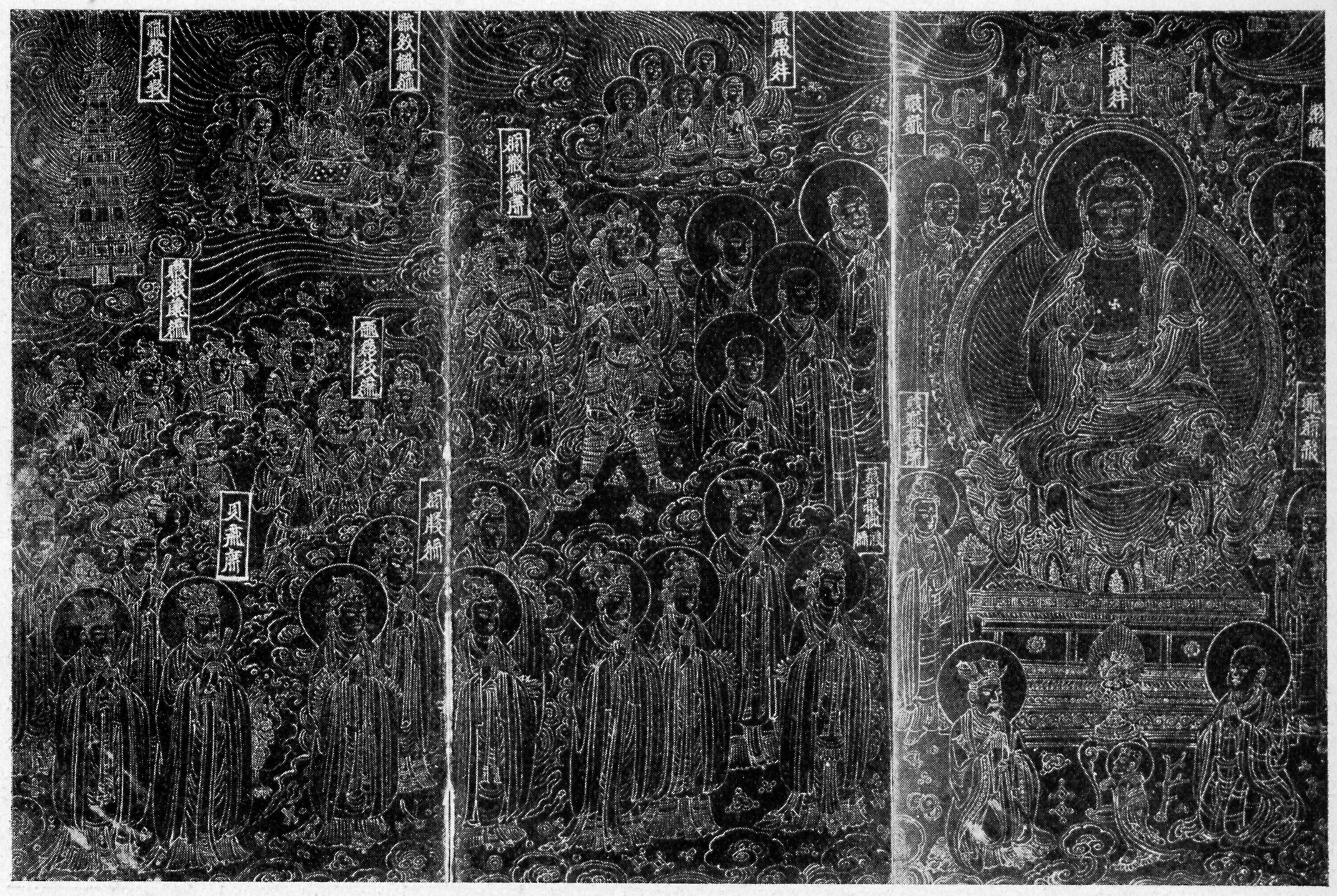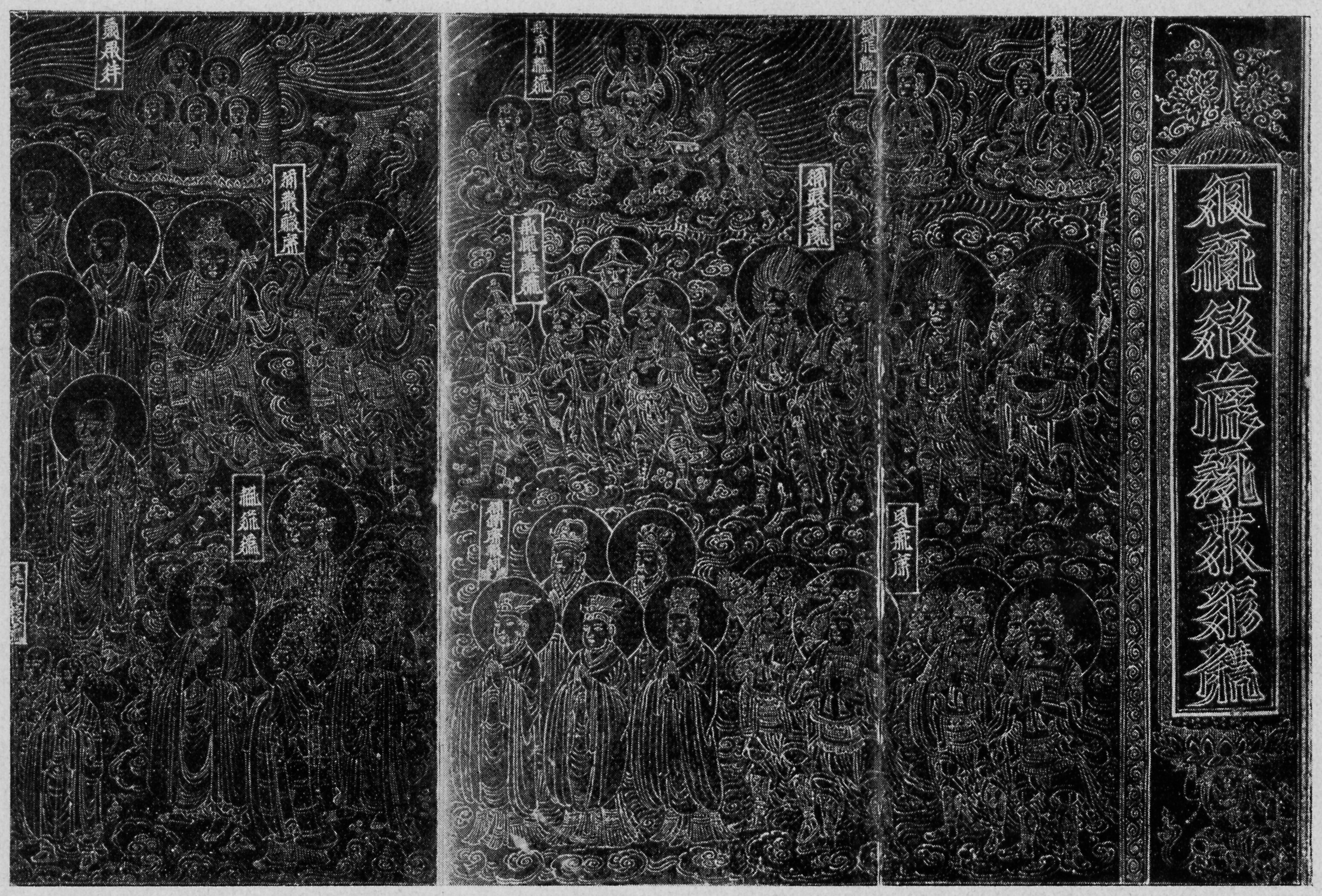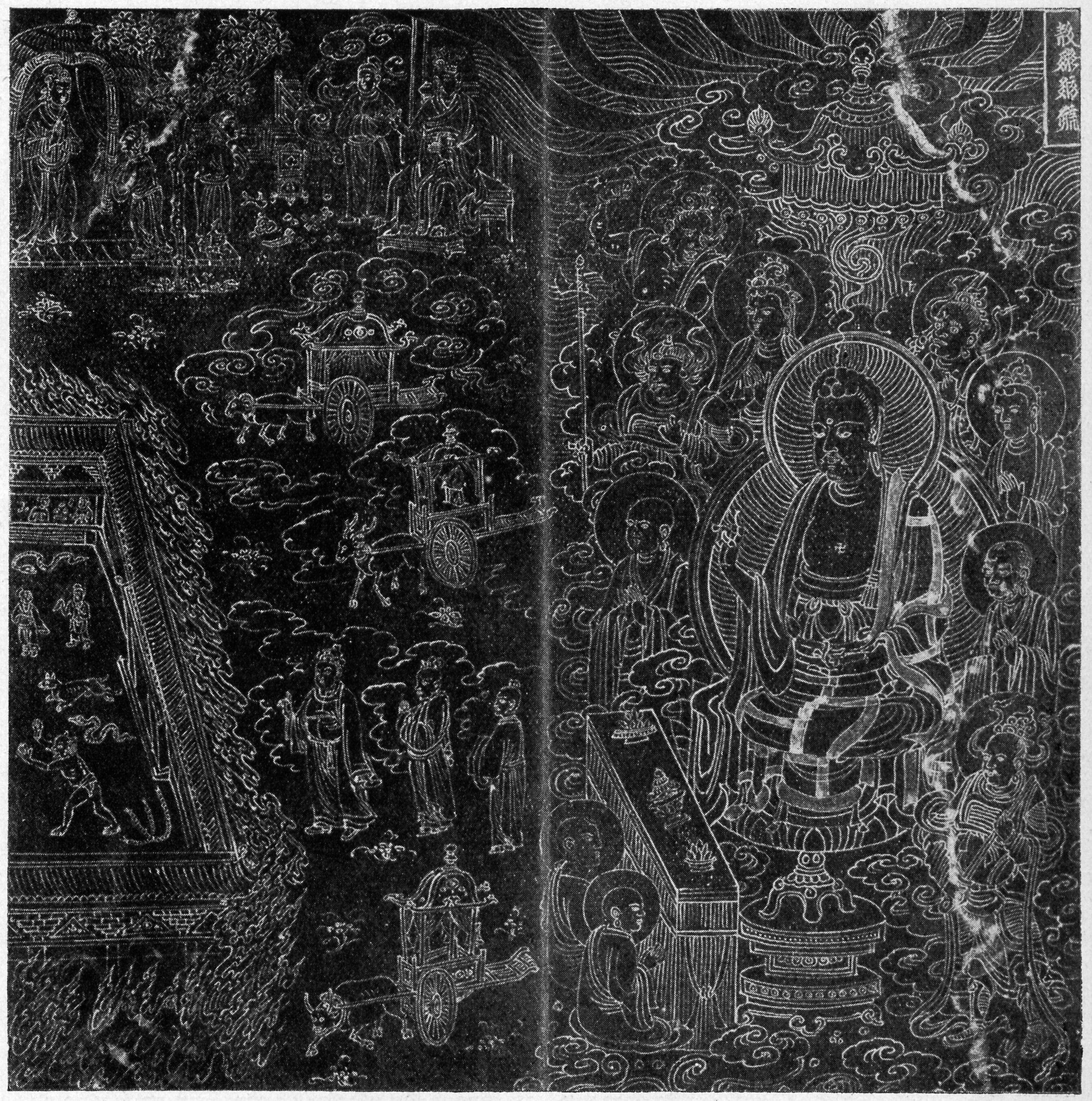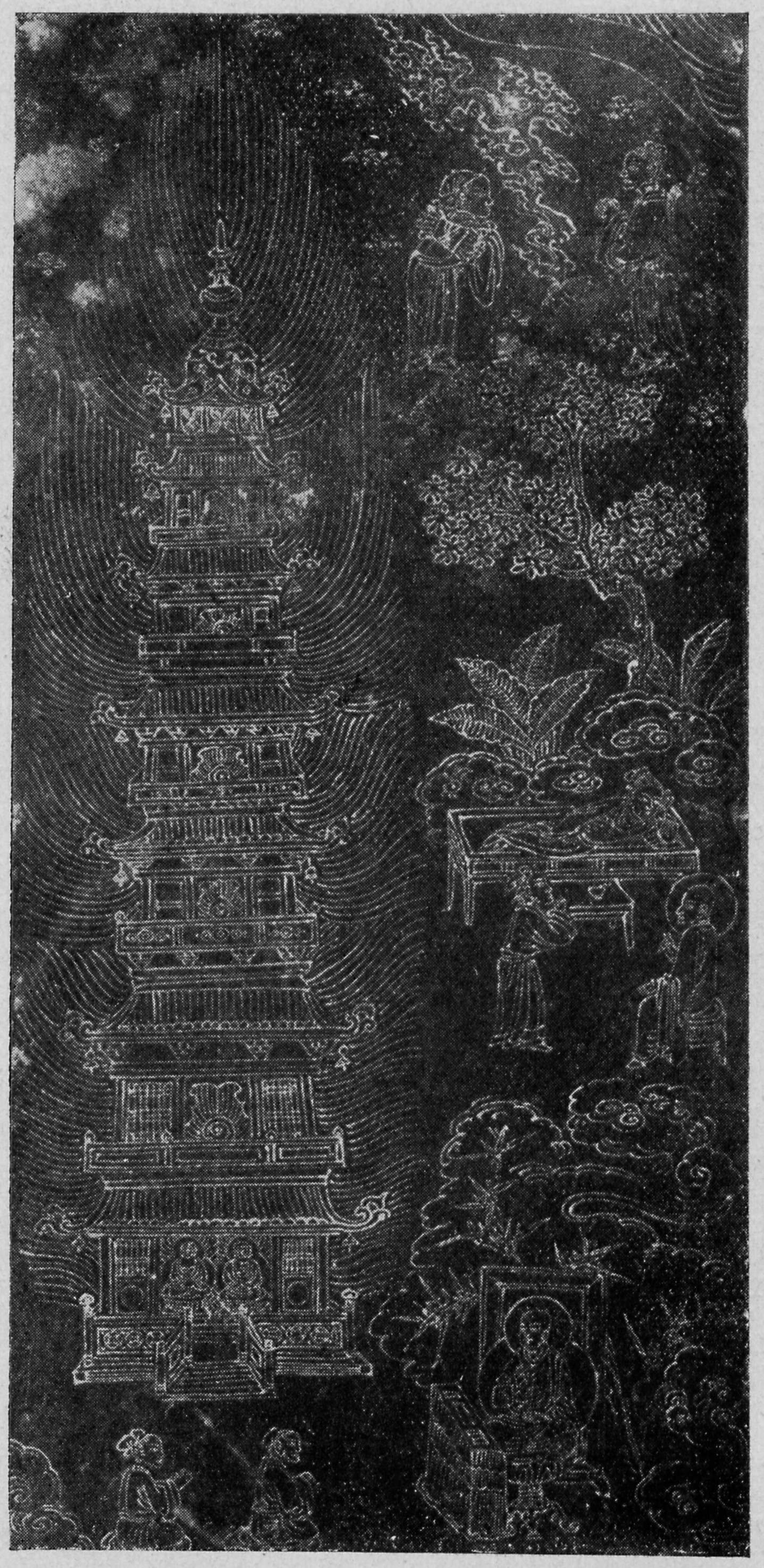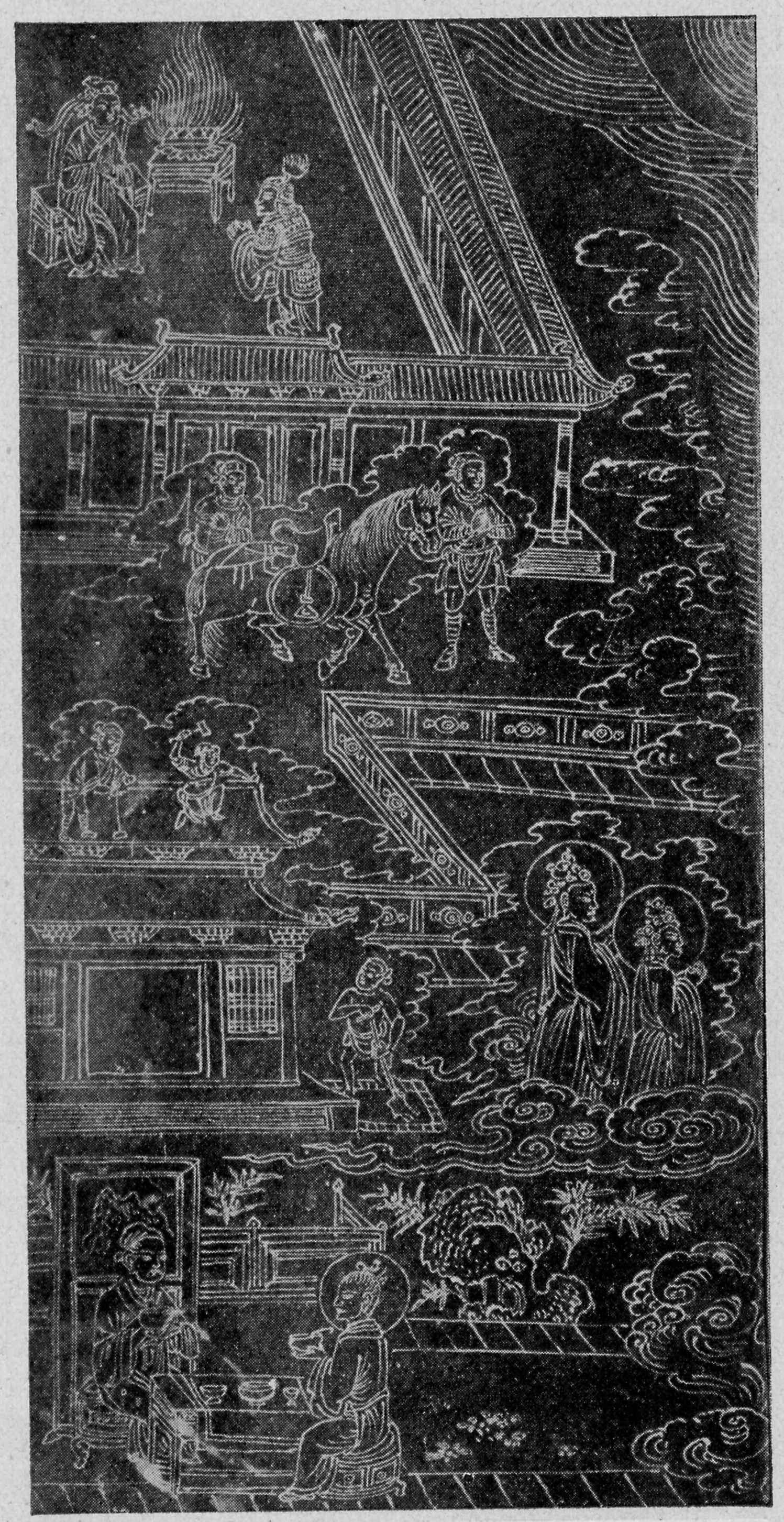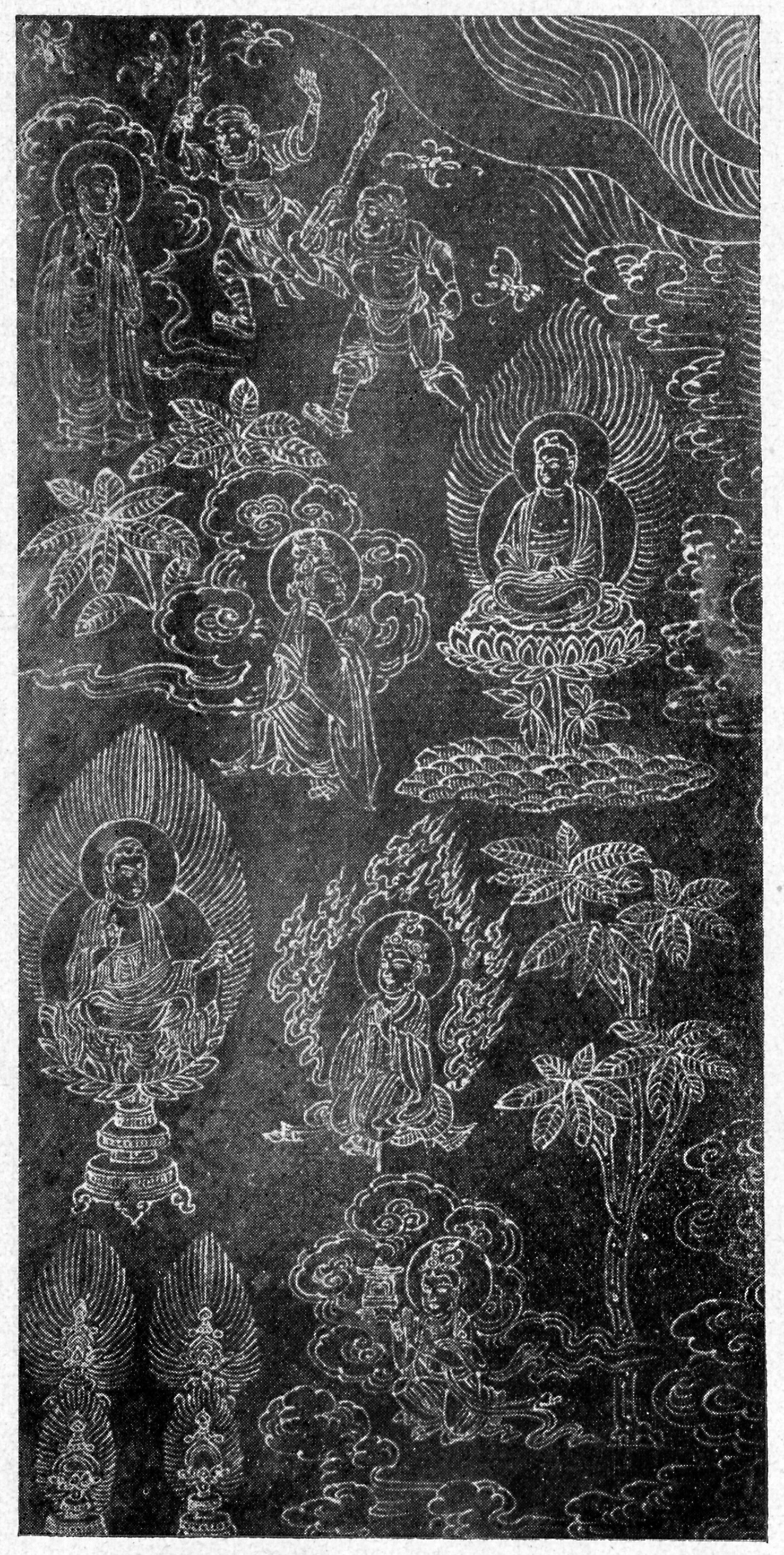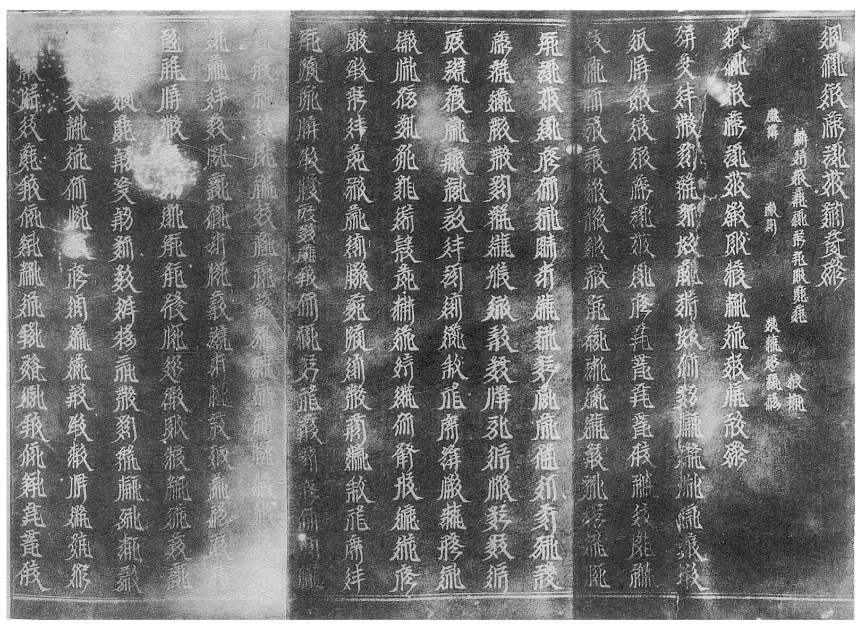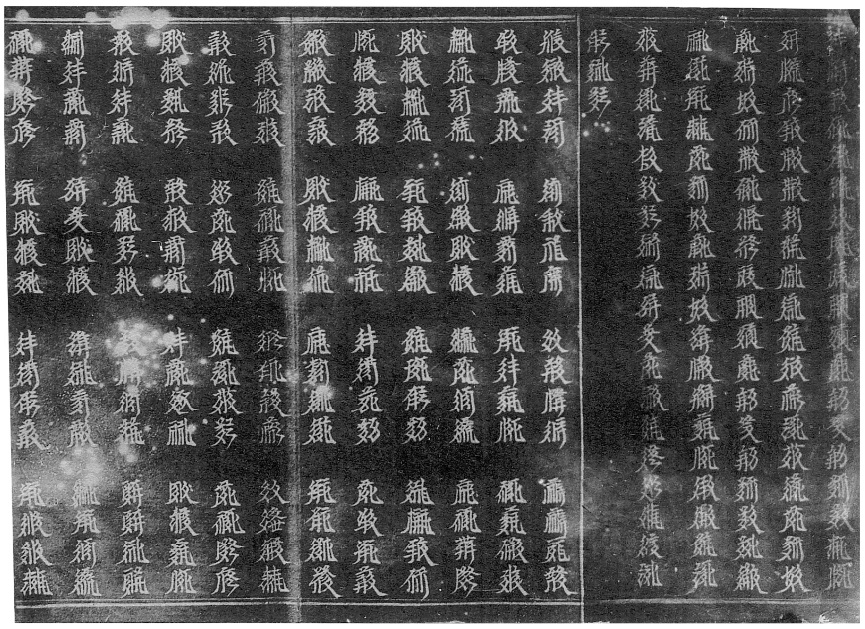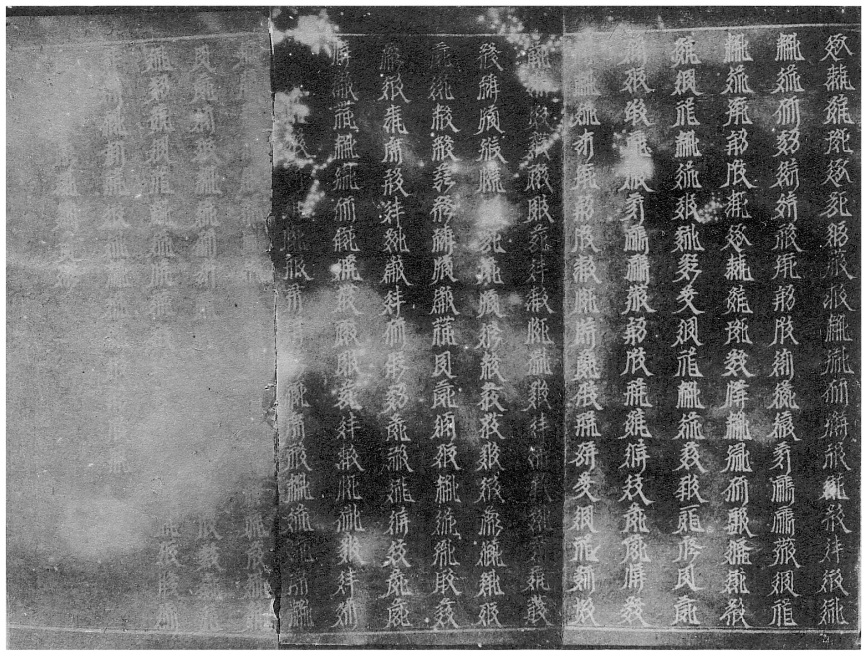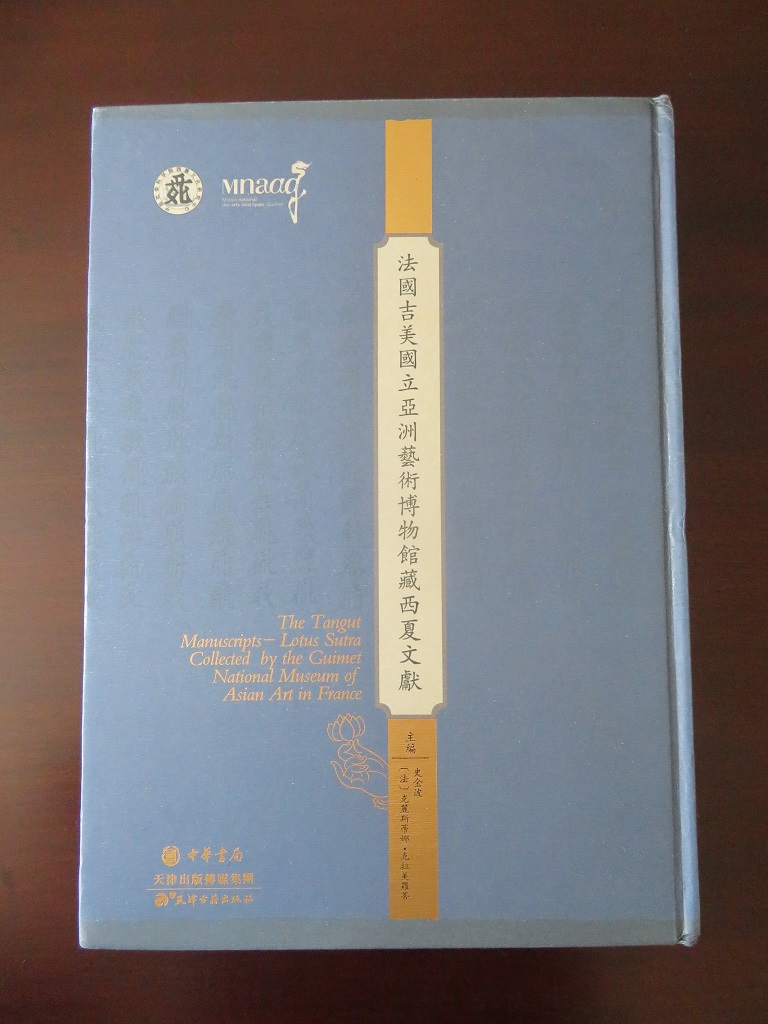BabelStone Blog
Sunday, 15 April 2018
Rediscovery of a Lost Tangut Manuscript
This post is about the rediscovery in June 2017 of a lost volume of a Tangut manuscript of a Buddhist sutra by Dr. Darui Long, Professor of Chinese religions at the University of the West in California. His discovery of one volume of a very fine Tangut manuscript of the Lotus Sutra written in gold ink at Jagiellonian University Library in Kraków, Poland was made public in this interview that was published by the University of the West on 4 April 2018, and which I read on 12 April.
Gold-inked Tangut version of the Lotus Sutra rediscovered at Jagiellonian Library by Dr. Darui Long
Photograph by Dr. Darui Long
The manuscript is in concertina format, with four pages opened up in this photograph. According to Morisse 1904 each volume is 12 cm × 33 cm when closed.
Case for the rediscovered Tangut sutra
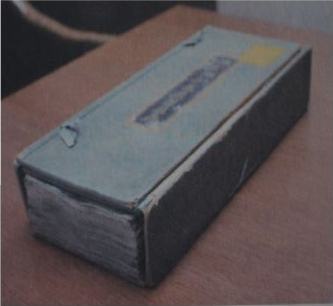
Photograph by Dr. Darui Long
The case matches the description given by Morisse: Chaque volume se présente renfermé dans une enveloppe ou t'ao de carton épais, doublé à l'intérieur d'une mince soie jaunie, et, à l'extérnieur, de soie bleue ornée de fleurs et de feuilles d'or peintes au trait ("Each volume is enclosed in an envelope or case [套] made of thick card, lined inside with thin yellow silk, and outside with blue silk adorned with flowers and gold leaf line painting").
Cover of the rediscovered Tangut sutra
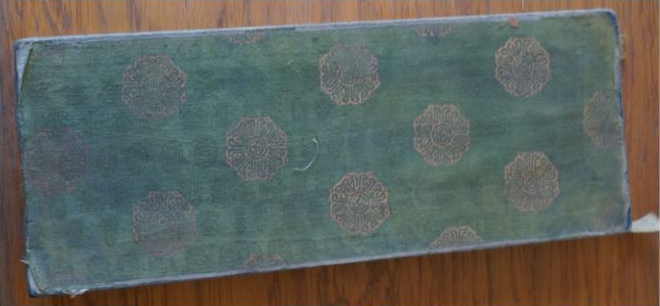
Photograph by Dr. Darui Long
The cover matches the description given by Morisse: Les volumes eux-mêmes, recouverts de soie brochée verte ("The volumes themselves are covered with green silk brocade").
Original Discovery
The first recorded discovery of any Tangut books in the modern era occurred in Beijing in 1900, during the chaotic aftermath of the Boxer Rebellion, when three Frenchmen found six volumes of a very fine gold-inked (chrysographic) manuscript of a Tangut translation of a the Lotus Sutra. Prior to this discovery, the Tangut script was only known from a bilingual Chinese-Tangut inscription dated 1094 on a stele from Liangzhou in modern Gansu, from a set of Buddhist inscriptions in six scripts engraved on the mid-14th-century Cloud Platform at Juyong Pass outside Beijing, and from sundry Western Xia bronze coins with Tangut inscriptions.
The three discoverers of these Tangut books were:
- Georges Morisse (d. 18 September 1910 at Hankou), who was at the time an interpreter at the French Legation in Beijing, and later went on to become Consul-General for France.
- Fernand Berteaux (d. 4 January 1928 in France), who was at the time an interpreter at the French Consulate in Shanghai, and later translator and Vice-Consul in charge of the Chancery at the French Legation at Seoul in Korea, and Consul for Manchuria.
- Paul Pelliot (1878–1945), who was at the time just starting out on what would be a long and distinguished career as a sinologist. In January 1900, after studying Chinese in Paris for two years, Pelliot had been appointed as a research scholar at the École Française d'Extrême-Orient in Hanoi, but he was immediately dispatched to Beijing in order to acquire Chinese books for the school, and subsequently became caught up in the siege of foreign legations during the Boxer Rebellion, returning to Hanoi in January 1901.
In August 1900, immediately after the lifting of the 55-day Siege of the International Legations in Beijing, these three Frenchmen discovered six concertina-format volumes of a Buddhist sutra written in an unknown script and language within a disordered heap of books and papers at the White Pagoda in Beijing. The text of the sutra was written in gold ink, and each volume was wrapped in a fine silk embroidered case. Pelliot gave the volume he picked up from the pile to his two companions as they had an official capacity in the French legation, and so in the end Morisse and Berteaux each took possession of three of the six volumes. Pelliot left empty-handed, although Morisse lent him one of his volumes to show at the First Congress of Orientalists held in Hanoi in December 1902.
Actually, the date of discovery is not certain. The siege of the legation quarter was lifted on 14 August 1900, so it must have been after this date, and some time before Pelliot returned to Hanoi in January 1901. Later authors state that the discovery was made in August 1900, but neither Morisse nor Pelliot specify the exact date or even the month, so we cannot be sure that it really was in August that the books were found.
Although Morisse could not read the Tangut script, he knew that the volumes belonged to the Lotus Sutra because there was a card with the title written in Chinese attached to the title page of the first volume (see Appendix A below). According to Morisse the Lotus Sutra should comprise at least seven or eight volumes (the standard Chinese text of the Lotus Sutra is seven volumes), so he thought that one or two volumes of the Tangut manuscript were missing, and had perhaps already been taken from White Pagoda before he and his companions had arrived. He asked around the booksellers of Beijing for information, and one bookseller assured him that a volume similar to the one Morisse had shown him had indeed been sold in the market at Beijing, but he did not know who the buyer was, or even if they were European or Chinese. Despite all his efforts, Morisse was unable to trace the putative purchaser of the missing volume.
But Where ?
There are two Tibetan-style stupa-shaped white pagodas in the old city of Beijing, both situated near the Imperial Palace. Both are known as the White Pagoda (Báitǎ 白塔). For many years, right up until a few days ago, I have confidently assumed that the "white pagoda" where the Tangut books were found was the Yuan dynasty white pagoda of Miaoying Temple (妙應寺, known colloquially as the White Pagoda Temple 白塔寺) which Kublai Khan ordered to be built as a replacement for an existing Liao dynasty pagoda in 1271. The huge white pagoda was constructed under the direction of the Nepalese architect Araniko, and was completed in 1279. The pagoda was the centrepiece for a new temple built between 1272 and 1288 that was named the Da Shengshou Wan'an Temple 大聖壽萬安寺. In the Ming dynasty it was renamed Miaoying Temple after renovations completed in 1468.
Last September when I visited the White Pagoda Temple in Beijing I noted that six volumes of Tangut sutras had been found there in 1900, and I recorded with dismay that "I do not know what happened to the other three volumes". Little did I suspect when I wrote those words that one of the missing volumes had been rediscovered in Poland just three months earlier by Dr. Darui Long.
View of the White Pagoda of Miaoying Temple (19 September 2017)
See my post on Three Beijing Pagodas for more information on the White Pagoda, and pictures of relics deposited in the pagoda by the Qianlong emperor in 1753.
After the destruction of the Western Xia kingdom, many Tangut soldiers and monks settled in Northern China (see my posts on the Tangut families of Laosuo and Xiaoli Qianbu). Indeed, Tangut communities were active and still writing in Tangut language in Northern China up to the middle of the Ming dynasty, as evidenced by two dharani pillars with Tangut inscriptions dated 1502 that were found at the site of a White Pagoda temple in Baoding.
Tangut Dharani Pillars erected in 1502
See my post on the Ancient Lotus Pond in Baoding for more information.
The white pagoda at Miaoying Temple was built during the Yuan dynasty, and as a major Buddhist temple in the Tibetan tradition it is highly likely that during the Yuan dynasty it would have housed Tangut monks and Tangut sutras. On the other hand, the white pagoda of Yong'an Temple (永安寺) situated on an island in Beihai Park at the northwest corner of the Imperial Palace was only built in 1651 during the early Qing dynasty, long after the demise of Tangut learning, so I thought it extremely unlikely that any Tangut sutras would have been deposited in this pagoda.
Then I read the interview with Dr. Long in which he stated that he did not know which of the two white pagodas in Beijing the Tangut sutras were found near, and so I did some digging. Kychanov 1995 and Galambos 2015 (see Appendix A below) both state that the books were found at the "White Pagoda" but do not specify which one it was. However, Kychanov 2005 does specifically state that it was the Yuan dynasty White Pagoda of Miaoying Temple, so Kychanov at least fell into the same trap as me. Morisse's 1904 study of the Tangut volumes in his possession throws no light on the matter, as he does not describe the circumstances of the discovery, and merely mentions that the books "fell into his hands" following the events of 1900. The most reliable account the discovery that I have found is by Paul Pelliot, who in a book review of 1932 (see Appendix A below), states that the books were recovered from a disordered heap of papers and books at the White Pagoda in Beijing, and he crucially qualifies that it is "the hill that the soldiers call the "peppermint bottle", and which the Europeans often but inaccurately call Coal Hill" (la colline que les soldats appelaient la "bouteille de pippermint", et que les Européens appellent souvent, mais inexactement, la Montagne de charbon). This can only refer to the early Qing White Pagoda in Beihai Park, as the island it is on is immediately west of Coal Hill 煤山 (formally Prospect Hill 景山). The white pagoda of Miaoying Temple is not on a hill at all.
View of the White Pagoda of Beihai Park
Poster for Pippermint GET

Pippermint Get 200 ans d'histoire
Detail of a Late Qing Map of Beijing showing the White Pagoda at Beihai
From a reprint of a Late Qing map entitled "Complete Map of the Inner and Outer Districts of the Capital City" (Jīngchéng nèiwài shǒushàn quántú 京城内外首善全圖) printed and sold by the Zhengyang Shuju 正陽書局 bookshop.
The large red circle marks the white pagoda on Jade Flower Island (Qiongdao 瓊島) in Beihai Lake. Coal Hill (labelled 景山) is a little to the east, above the north wall of the palace. The white pagoda of Miaoying Temple near Fucheng Gate 阜城門 is not labelled on the map, but I mark its position with a small red circle. The North Cathedral, known as Beitang 北堂, which was separately besieged by the Boxers during June to August 1900, is located at Xishiku 西什庫, a little to the west of Beihai Lake.
As Pelliot clearly indicates that the books were found by him and his two compatriots at the White Pagoda by Coal Hill, we have no choice but to accept that these Tangut books really were housed in the Qing dynasty white pagoda rather then the Yuan dynasty white pagoda. Actually, this does make sense. The pagoda was built in 1651 on the orders of the Shunzhi Emperor in honour of the visit to Beijing of the 5th Dalai Lama (he was invited in 1649, and arrived in 1652). There was no earlier Buddhist temple on the site, and the Yong'an Temple associated with the white pagoda was converted from existing buildings on the island, so when suitable Buddhist relics and sutras were sought to be interred inside the new pagoda or deposited in the new temple library it would have been necessary to look to other Buddhist temples in the capital. Miaoying Temple was located nearby (2.5 km to the west), and the high quality Tangut sutras written in gold ink would surely have been considered to be ideal for this purpose. The fact that the text was written in an unknown foreign script may have made them especially suitable for depositing in a temple built to honour the Tibetan Dalai Lama. It is easy to imagine that when the Emperor showed the Dalai Lama around the new temple and pagoda built in his honour, the golden sutras would have taken pride of place among the treasured volumes in the temple library that were proudly displayed to the Dalai Lama.
The golden Tangut sutras are not ordinary Buddhist texts for daily use by monks, but are high status items that must have been written for some special purpose on behalf of an emperor (see discussion of the Western Xia gold-inked Golden Light Sutra below). I think it is unlikely that the gold-inked sutra found in 1900 was a relic from the Western Xia kingdom, but it is more probable that it was written in Beijing during the Yuan dynasty. I believe that the most likely scenario is that the golden sutra was commissioned from Tangut monks by Kublai Khan c. 1271–1279 in order to commemorate the construction of the Wan'an Temple and its white pagoda. The sutra would have been housed in the temple until 1651, when it was relocated to the Yong'an Temple in Beihai Lake in honour of the visit of the 5th Dalai Lama. There it remained until 1900 when the temple was ransacked (by Boxers or by Western troops), and the sacred books which were valueless to the ransackers were thrown out in a heap, later to be picked over by Morisse, Berteaux and Pelliot.
Lost and Found
What became of the six volumes discovered by Morisse, Berteaux and Pelliot?
According to Pelliot, writing in 1932 (see Appendix A below), the widow of Fernand Berteaux, who had died in January 1928, sold his three volumes, and they were now held at the Guimet Museum (Musée Guimet) in Paris. Pelliot does not say exactly who Mme. Berteaux sold the books to, but Kychanov 1995 and Galambos 2015 both state that she sold the three volumes separately to different buyers, and that they were later acquired by the Guimet Museum. It seems a little implausible that the three volumes were dispersed and then ended up together again at the Guimet Museum, so I think it is more probable that the widow sold them to a single buyer or directly to the Guimet Museum.
The three Tangut volumes owned by Berteaux (vols. 2, 6, and 8) are still at the Guimet Museum, and low resolution images of all pages of the three volumes are available on the Images d'art website.
Vols. 2, 6, and 8 of the Tangut Lotus Sutra held at the Guimet Museum
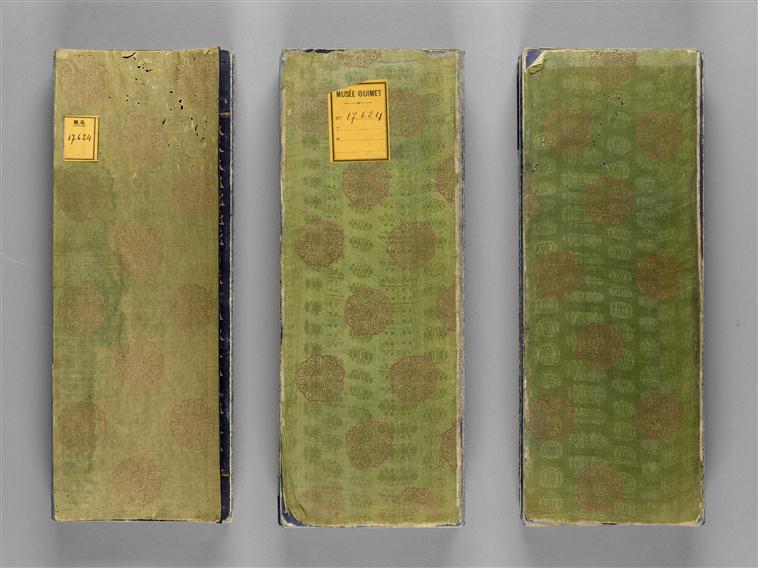
Source: Images d'art
Case with Tangut label for vol. 2 of the Lotus Sutra held at the Guimet Museum
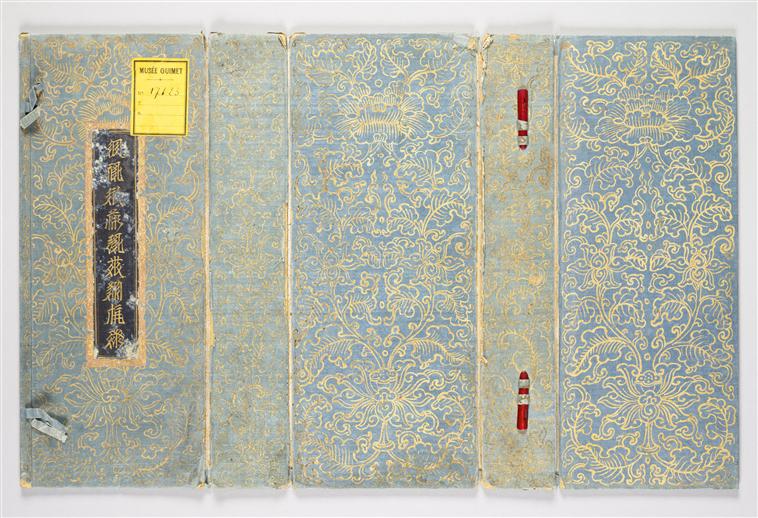
𗤓𗹙𗤻𗑗𗖰𗚩𘐳𗍫𗡪
Source: Images d'art
Opening pages of vol. 2 of the Lotus Sutra held at the Guimet Museum
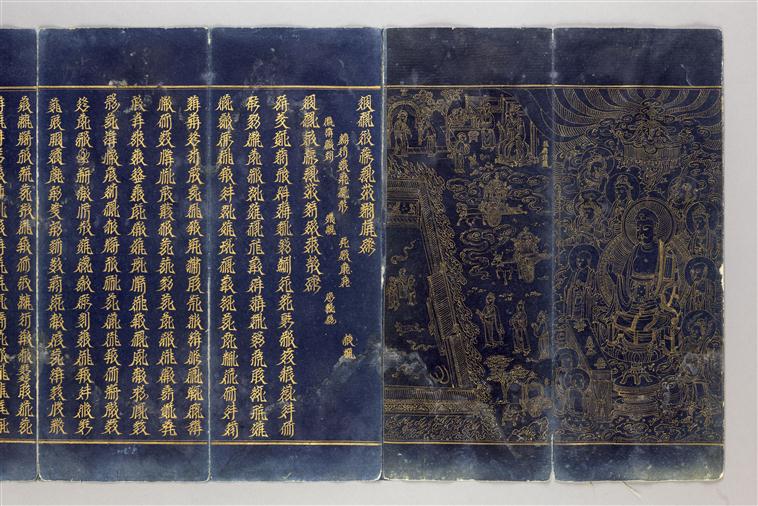
Source: Images d'art
Illustration for vol. 6 of the Lotus Sutra held at the Guimet Museum

Source: Images d'art
Opening text for vol. 6 of the Lotus Sutra held at the Guimet Museum
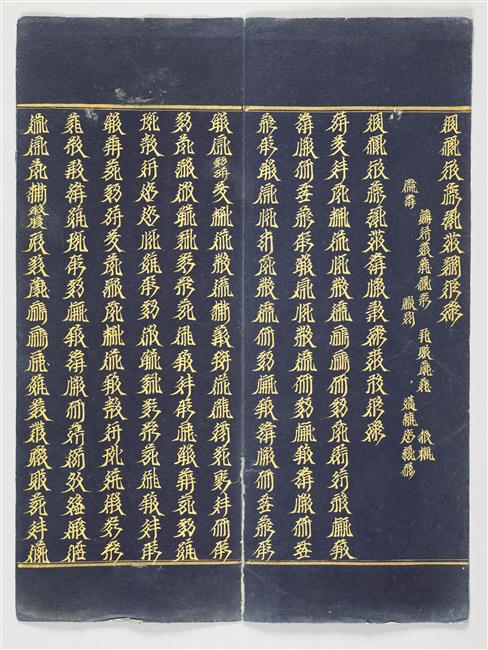
Source: Images d'art
Opening pages of vol. 8 of the Lotus Sutra held at the Guimet Museum
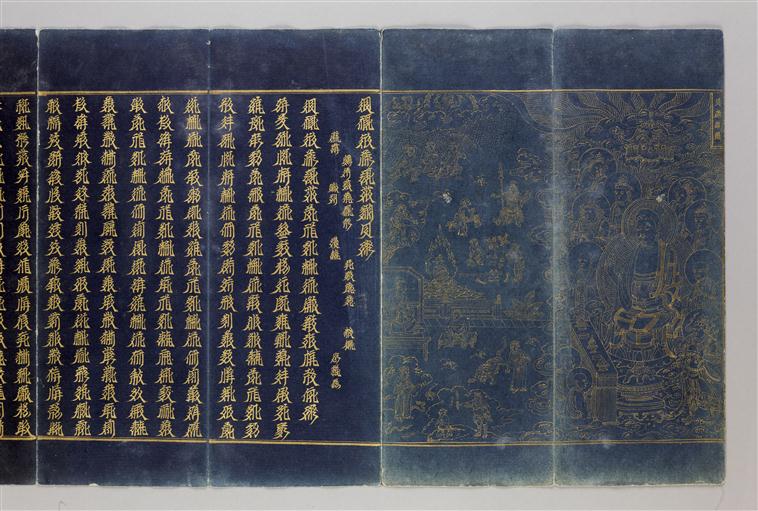
Source: Images d'art
Pelliot also records that Georges Morisse sold his three volumes to the Berlin Library around 1912. Actually, Morisse died in China in September 1910 (sadly before he had the opportunity to publish the anticipated sequel to his preliminary study of the Tangut sutra), so it is more likely that it was Morisse's widow who sold his books to the Prussian State Library (now the Berlin State Library) after his death. [See Addendum A for an update on the Berlin volumes.]
The three volumes belonging to Morisse are no longer held at the Berlin State Library, and up until a few days ago it was a mystery to me as to what happened to them. According to the interview with Dr. Darui Long, during World War II Berlin was not a safe place for books, and so in 1941 after the library had been hit during a bombing raid, most of the important and valuable books in the Berlin State Library were packed up and removed from the library to safeguard them from bombing. The books were distributed to various monasteries and castles elsewhere in Germany and in other places under German control. One of the chosen destinations was Książ Castle in the west of Poland. After the war, the books sent to Książ Castle were not returned to Berlin, but were instead sent to the library of Jagiellonian University in Kraków.
The Berlin books remained at the Jagiellonian Library, largely uninvestigated, for many decades, until in 2016 Dr. Darui Long visited the university library in search of Chinese Buddhist texts belonging to the Yongle Northern Canon. After spending two weeks at the library in 2016, he returned in the summer of 2017 for another three weeks of research, and it was on 9 June 2017 that he came across a manuscript very unlike all the other Chinese Buddhist manuscripts he had been making notes on. This was one of the three volumes of the gold-inked Tangut Lotus Sutra belonging to Morisse, still in its original case. This is the story in Dr. Long's own words:
I spent almost two weeks for the first time in 2016. They showed me the 68 volumes and I made detailed notes, but I realized they were not what I was looking for. I showed them the photos from James Robinson and they didn’t recognize them. Their catalog is in enumerating figures so it cannot help you with anything. No Sanskrit words. No Chinese words. Not a single word except for Chinese Buddhist scripture. So I said, “Why don’t you bring me out 637, 637A, 637B?” Once they brought out 3 boxes of 637, 637A, 637B I realized they are three of the same different prints. Contents are the same, but they are different in size and package. Just like the Bible, you have so many different Bibles. Well, they probably belong to the same edition printed in 1598, 1594, and 1596. So they are different prints of the same Buddhist Canon.
I asked them, “How many do you have?” They showed me the catalog and I realized they have at least 403 packages. The next day I had to fly back so I said, “Ok, I’ll have to do it next year.” So I applied for a scholarship from University of the West. They gave me a great endorsement and I went there again for three weeks. Well, I could hardly imagine in those three weeks…well…there is no Chinese food [laughter]. I had to cook by myself. Well, it doesn’t matter; I should endure all the hardships. But it was very fruitful. So every day I checked the sources. Their librarian would send me carts filled with probably 20 packages of Canon. So on June 9th, I accidentally found one volume which was much smaller. I took a look. As I studied the history of Chinese printing, I realized it was Xi Xia, or Tangut.
Interview: Dr. Darui Long Rediscovers Rare Buddhist Manuscript in Kraków, Poland (4 April 2018)
In July 2017 Dr. Long went to Beijing and met with renowned Tangut expert Prof. Shi Jinbo who verified that the manuscript comprised four chapters of the Tangut version of the Saddharma Puṇḍarīka Sūtra (Chinese miàofǎ liánhuá jīng 妙法蓮華經) (i.e. the Lotus Sutra), and that it was one of the volumes collected by Morisse and Berteaux in 1900.
But that still leaves two of Morisse's three volumes unaccounted for. Where are these last two volumes? Are they also at Jagiellonian Library, waiting to be unwrapped? Or were they sent elsewhere from Berlin, and still lie unrecognised in a castle or monastery or library in Germany or a neighbouring country? Or were they destroyed during the war? I hope that this question can be answered soon.
Morisse's Study of the Tangut text
In 1904 Morisse published a groundbreaking preliminary study of his three volumes of the Tangut sutra, entitled Contribution préliminaire à l'étude de l'écriture et de la langue si-hia (available for download from Gallica or Persée). His book includes facsimile plates (clichés) of the first three pages of chapter 1, shown below.
The title of the text in Tangut is given as 𗤓𗹙𗤻𗑗𗖰𗚩 which directly translates the Chinese title 妙法蓮華經 (Miàofǎ liánhuá jīng) "Wonderful Dharma Lotus Flower Sutra", corresponding to the Sanskrit title Saddharmapuṇḍarīka-sūtra. The Chinese text is Taishō Tripiṭaka No. 262, which comprises seven volumes.
Lotus Sutra vol. 1 p. 1
Lotus Sutra vol. 1 p. 2
Lotus Sutra vol. 1 p. 3
There are two features about the reproductions that have caused confusion, and require some explanation. Firstly, the Tangut characters have been numbered sequentially with Arabic numbers, and most of the Tangut characters have a Chinese single-character annotation on the right side, some circled (which are phonetic glosses) and some not (which are semantic glosses). The Arabic numbers must have been added by Morisse, but Nevsky thought that the interlinear Chinese characters had been added by an unknown Chinese decipherer before Morisse found the manuscript ("Chinese equivalents have been written to the right of certain characters, and undoubtedly by a Chinese", quoted in Kychanov 2005), and it was only with the help of this unknown scholar that Morisse was able to decipher the Tangut characters. However, Pelliot refutes this theory, and asserts that it was Morisse himself who wrote in all the Chinese characters as part of the process of decipherment. Morisse's achievement in deciphering so many Tangut characters is truly astounding, and he should be given full credit for it.
Secondly, the reproductions look as if the text is written in black ink on light paper, and Nevsky apparently thought that in addition to the main text in gold ink there were some ordinary pages in black ink which Morisse reproduced in his study. Pelliot 1932 also refutes this suggestion, and confirms that all the pages in all volumes were written with gold ink on dark blue paper. Therefore the reproductions given by Morisse must be negative prints of the original pages (a negative greyscale version of the photograph of the Jagiellonian University Library copy that I made looks very similar to Morisse's clichés). As the annotations must have been written in dark ink, we can conclude that Morisse wrote his annotations on negative prints of the manuscript, and these annotated negative copies are reproduced in Morisse's 1904 study.
A further point of confusion in the various sources is how many Tangut characters Morisse was able to interpret. In Bushell's 1904 review of Morisse's study he writes that Morisse classifies some 3,500 Tangut characters, and this figure of 3,500 classified Tangut characters is echoed by Galambos 2015. This seems to me to imply that Morisse classified 3,500 different Tangut characters, which is more than half the total number of characters given in Tangut dictionaries. I am pretty sure that the Tangut translation of the Lotus Sutra has far fewer than 3,500 separate characters, and his 1904 study certainly does not list anywhere near that many. The source of this confusion can be found on p. 10 of Morisse's study where he mentions that "Ce caractère ne s'étant plus rencontré dans la partie du texte jusqu'ici dépouillée (3,500 caractères), je m'abstiens, suivant le principe que je me suis imposé, de lui attribuer une valeur phonétique" ["This character is not yet found in the part of the text closely examined so far (3,500 characters), so I refrain, following the principle I have imposed on myself, from giving it a phonetic value"]. So evidently, the 3,500 characters refers to the length of the text that Morisse had thus far studied, and is not the number of unique characters he had identified. Kychanov 1995 says Morisse established the meaning and approximate pronunciation of about 300 characters, but this also seems to be incorrect. By my count, Morisse lists 174 Tangut characters with meanings (pp. 39–44), and lists 29 Tangut characters with meanings and pronunciations (pp. 45–46), 203 in total. In addition, Morisse lists on p. 44 a further 13 characters with meanings identified by Bushell that do not occur in Morisse's volumes. Perhaps Kychanov's "about 300 characters" is a mistake based on Morisse's list of 305 numbered notes for all 305 individual Tangut characters (not unique characters) written on the first three pages of the sutra (pp. 51–67, cf. the 305 numbered characters in the facsimile reproductions).
Morisse's interpretation of the first three pages of the text (305 characters) is shown below. This is based on the facsimile plates reproduced above and on his notes given on pp. 51–67. In almost all cases his interpretations are correct. Circled Chinese characters in Morisse's study indicate that these characters are used as phonetic transcriptions for Sanskrit, and their Chinese reading should represent the approximate reading for the corresponding Tangut character (which turns out to be true). Uncircled Chinese characters indicate the Chinese meaning of the corresponding Tangut character. Circled Chinese characters are represented in the table below as uncircled characters on a grey background.
| No. | Tangut | Chinese |
|---|---|---|
| 001 | 𗤓 | 妙 |
| 002 | 𗹙 | 法 |
| 003 | 𗤻 | 華 |
| 004 | 𗑗 | 淨? |
| 005 | 𗖰 | 經 |
| 006 | 𗚩 | 典? |
| 007 | 𘈩 | 一 |
| 008 | 𗡪 | 第? |
| 009 | 𘝗 | 姚? |
| 010 | 𗣭 | 秦? |
| 011 | 𗛰 | |
| 012 | 𗔇 | |
| 013 | 𗹙 | 法 |
| 014 | 𘘚 | 師 |
| 015 | 𘃳 | 鳩 |
| 016 | 𘉒 | 摩 |
| 017 | 𗓽 | 羅 |
| 018 | 𗒅 | 什 |
| 019 | 𘂜 | |
| 020 | 𗯝 | 譯? |
| 021 | 𗫈 | 今? |
| 022 | 𗌮 | |
| 023 | 𘓺 | 天 |
| 024 | 𘋨 | 帝? |
| 025 | 𗿢 | |
| 026 | 𗖵 | |
| 027 | 𗫸 | 重? |
| 028 | 𘜏 | |
| 029 | 𗹑 | |
| 030 | 𗤓 | 妙 |
| 031 | 𗹙 | 法 |
| 032 | 𗤻 | 華 |
| 033 | 𗑗 | 淨? |
| 034 | 𗖰 | 經 |
| 035 | 𗚩 | 典? |
| 036 | 𘁨 | 序 |
| 037 | 𘄿 | 品? |
| 038 | 𘈩 | 一 |
| 039 | 𗡪 | 第? |
| 040 | 𘌽 | 是 |
| 041 | 𗍊 | 如 |
| 042 | 𗔘 | |
| 043 | 𗧓 | 我 |
| 044 | 𘃞 | |
| 045 | 𗿳 | 時? |
| 046 | 𗢳 | 佛 |
| 047 | 𘟙 | 王 |
| 048 | 𗎭 | 舍 |
| 049 | 𗍁 | 城? |
| 050 | 𗒯 | 耆 |
| 051 | 𘛣 | 闍 |
| 052 | 𗼠 | 崛? |
| 053 | 𘑗 | 山 |
| 054 | 𘂤 | 中 |
| 055 | 𗫻 | 住 |
| 056 | 𘜶 | 大 |
| 057 | 𘜉 | 比 |
| 058 | 𗴼 | 丘 |
| 059 | 𗫔 | 衆 |
| 060 | 𗕑 | 萬 |
| 061 | 𗍫 | 二 |
| 062 | 𗡞 | 千 |
| 063 | 𘓐 | 人 |
| 064 | 𗑠 | 俱? |
| 065 | 𗄭 | |
| 066 | 𗄊 | 皆 |
| 067 | 𗠝 | 阿 |
| 068 | 𗓽 | 羅 |
| 069 | 𘂦 | 漢 |
| 070 | 𘟂 | |
| 071 | 𗱕 | 諸 |
| 072 | 𗦎 | 漏? |
| 073 | 𗋚 | 已? |
| 074 | 𗈞 | 盡 |
| 075 | 𗉛 | |
| 076 | 𗷫 | |
| 077 | 𘂆 | 亦? |
| 078 | 𗤋 | 無? |
| 079 | 𘝵 | 己? |
| 080 | 𘞙 | |
| 081 | 𗄊 | 皆 |
| 082 | 𗟧 | 得 |
| 083 | 𗱕 | 諸 |
| 084 | 𘟣 | 有? |
| 085 | 𗲄 | |
| 086 | 𗺑 | |
| 087 | 𗤶 | 心 |
| 088 | 𘝵 | 自? |
| 089 | 𗦳 | |
| 090 | 𗟧 | 得 |
| 091 | 𗳱 | |
| 092 | 𗗙 | 之 |
| 093 | 𗦻 | 名 |
| 094 | 𗫂 | 者 |
| 095 | 𗠝 | 阿 |
| 096 | 𘎑 | |
| 097 | 𘃳 | 憍 |
| 098 | 𘔜 | |
| 099 | 𗱡 | |
| 100 | 𗓚 | 摩 |
| 101 | 𘄽 | 訶 |
| 102 | 𗡝 | 迦 |
| 103 | 𘛣 | 葉 |
| 104 | 𗰨 | 優 |
| 105 | 𗜪 | 樓 |
| 106 | 𗙚 | |
| 107 | 𗓽 | 螺 |
| 108 | 𗡝 | 迦 |
| 109 | 𘛣 | 葉 |
| 110 | 𘀺 | 伽 |
| 111 | 𘁂 | 耶 |
| 112 | 𗡝 | 迦 |
| 113 | 𘛣 | 葉 |
| 114 | 𗅾 | 那 |
| 115 | 𗠰 | 提 |
| 116 | 𗡝 | 迦 |
| 117 | 𘛣 | 葉 |
| 118 | 𘛣 | 舍 |
| 119 | 𗓡 | |
| 120 | 𘈷 | 子 |
| 121 | 𘜶 | 大 |
| 122 | 𘂯 | |
| 123 | 𗣋 | |
| 124 | 𘍑 | 連 |
| 125 | 𗓚 | 摩 |
| 126 | 𘄽 | 訶 |
| 127 | 𗡝 | 迦 |
| 128 | 𗳻 | 旃 |
| 129 | 𗶕 | |
| 130 | 𗠝 | 阿 |
| 131 | 𘁳 | |
| 132 | 𗜪 | 樓 |
| 133 | 𗁬 | 馱 |
| 134 | 𗡝 | 劫 |
| 135 | 𗙤 | 賓 |
| 136 | 𗅾 | 那 |
| 137 | 𘃳 | 憍 |
| 138 | 𗏆 | 梵 |
| 139 | 𘏞 | 波 |
| 140 | 𗠰 | 提 |
| 141 | 𘄊 | |
| 142 | 𗣧 | 婆 |
| 143 | 𗸰 | 多 |
| 144 | 𗙤 | 畢 |
| 145 | 𘍑 | 陵 |
| 146 | 𗡝 | 伽 |
| 147 | 𗣧 | 婆 |
| 148 | 𗛹 | |
| 149 | 𗩙 | |
| 150 | 𗕾 | |
| 151 | 𗓽 | 羅 |
| 152 | 𗓚 | 摩 |
| 153 | 𘄽 | 訶 |
| 154 | 𘃳 | 拘 |
| 155 | 𗺋 | |
| 156 | 𗓽 | 羅 |
| 157 | 𗓰 | 難 |
| 158 | 𗁬 | 陀 |
| 159 | 𗐾 | |
| 160 | 𗁬 | 陀 |
| 161 | 𗓽 | 羅 |
| 162 | 𗓰 | 難 |
| 163 | 𗁬 | 陀 |
| 164 | 𗥑 | |
| 165 | 𗜪 | 樓 |
| 166 | 𗅾 | 那 |
| 167 | 𗓁 | 彌 |
| 168 | 𗸰 | 多 |
| 169 | 𗓽 | 羅 |
| 170 | 𘆵 | 尼 |
| 171 | 𘈷 | 子 |
| 172 | 𗍏 | 須 |
| 173 | 𘏞 | 菩 |
| 174 | 𘛛 | 提 |
| 175 | 𗥼 | |
| 176 | 𗓰 | 難 |
| 177 | 𗓽 | 羅 |
| 178 | 𗺹 | 睺 |
| 179 | 𗓽 | 羅 |
| 180 | 𘌽 | 是 |
| 181 | 𗍊 | 如 |
| 182 | 𗫔 | 衆 |
| 183 | 𗄻 | 知 |
| 184 | 𗹬 | |
| 185 | 𗱠 | |
| 186 | 𘜶 | 大 |
| 187 | 𗠝 | 阿 |
| 188 | 𗓽 | 羅 |
| 189 | 𘂦 | 漢 |
| 190 | 𘆄 | 等 |
| 191 | 𗅉 | 復 |
| 192 | 𗫦 | 學 |
| 193 | 𘟣 | 有? |
| 194 | 𗫦 | 學 |
| 195 | 𗤋 | 無? |
| 196 | 𗍫 | 二 |
| 197 | 𗡞 | 千 |
| 198 | 𘓐 | 人 |
| 199 | 𗓚 | 摩 |
| 200 | 𘄽 | 訶 |
| 201 | 𘏞 | 波 |
| 202 | 𘛣 | 闍 |
| 203 | 𘏞 | 波 |
| 204 | 𗠰 | 提 |
| 205 | 𘜉 | 比 |
| 206 | 𗴼 | 丘 |
| 207 | 𘆵 | 尼 |
| 208 | 𗑟 | |
| 209 | 𘎆 | |
| 210 | 𗤁 | 六 |
| 211 | 𗡞 | 千 |
| 212 | 𘓐 | 人 |
| 213 | 𗑠 | 俱? |
| 214 | 𗄭 | |
| 215 | 𗓽 | 羅 |
| 216 | 𗺹 | 睺 |
| 217 | 𗓽 | 羅 |
| 218 | 𗴺 | 母? |
| 219 | 𘁂 | 耶 |
| 220 | 𘞐 | 輸 |
| 221 | 𗁬 | 陀 |
| 222 | 𗓽 | 羅 |
| 223 | 𘜉 | 比 |
| 224 | 𗴼 | 丘 |
| 225 | 𘆵 | 尼 |
| 226 | 𗋕 | 復 |
| 227 | 𘂆 | 亦? |
| 228 | 𗑟 | |
| 229 | 𘎆 | |
| 230 | 𗑠 | 俱? |
| 231 | 𗄭 | |
| 232 | 𗅉 | 復 |
| 233 | 𘉋 | 八 |
| 234 | 𗕑 | 萬 |
| 235 | 𘏞 | 菩 |
| 236 | 𗢈 | 薩 |
| 237 | 𗓚 | 摩 |
| 238 | 𘄽 | 訶 |
| 239 | 𗢈 | 薩 |
| 240 | 𗄊 | 皆 |
| 241 | 𗠝 | 阿 |
| 242 | 𗷧 | 耨 |
| 243 | 𗸰 | 多 |
| 244 | 𗓽 | 羅 |
| 245 | 𘋅 | 三 |
| 246 | 𗴥 | 藐 |
| 247 | 𘋅 | 三 |
| 248 | 𘏞 | 菩 |
| 249 | 𘛛 | 提 |
| 250 | 𘕿 | |
| 251 | 𗅋 | 不 |
| 252 | 𗳜 | 退? |
| 253 | 𗆮 | 轉? |
| 254 | 𗐗 | |
| 255 | 𗁬 | 陀 |
| 256 | 𗓽 | 羅 |
| 257 | 𘆵 | 尼 |
| 258 | 𘎪 | 説 |
| 259 | 𗳘 | 樂? |
| 260 | 𗤮 | |
| 261 | 𘁾 | |
| 262 | 𗄊 | 皆 |
| 263 | 𗟧 | 得 |
| 264 | 𗅋 | 不 |
| 265 | 𗳜 | 退? |
| 266 | 𗆮 | 轉? |
| 267 | 𗹙 | 法 |
| 268 | 𘚢 | 輪? |
| 269 | 𘈧 | 轉 |
| 270 | 𗩱 | 能 |
| 271 | 𘖑 | |
| 272 | 𗆄 | |
| 273 | 𘊝 | 百 |
| 274 | 𗡞 | 千 |
| 275 | 𗱕 | 諸 |
| 276 | 𗢳 | 佛 |
| 277 | 𗗙 | 之 |
| 278 | 𗴿 | |
| 279 | 𗒀 | |
| 280 | 𗋕 | 復 |
| 281 | 𗱕 | 諸 |
| 282 | 𗢳 | 佛 |
| 283 | 𘋩 | |
| 284 | 𗫔 | 衆 |
| 285 | 𗣼 | 德 |
| 286 | 𗰜 | 本 |
| 287 | 𗽈 | |
| 288 | 𗏹 | 常 |
| 289 | 𗱕 | 諸 |
| 290 | 𗢳 | 佛 |
| 291 | 𗗙 | 之 |
| 292 | 𗡙 | 讚 |
| 293 | 𗜓 | 現 |
| 294 | 𗦇 | |
| 295 | 𗨻 | |
| 296 | 𗕿 | 慈 |
| 297 | 𗳒 | 以 |
| 298 | 𘛽 | 身 |
| 299 | 𗹢 | 修 |
| 300 | 𗢳 | 佛 |
| 301 | 𘟛 | 慧 |
| 302 | 𘃽 | 入 |
| 303 | 𗩱 | 能 |
| 304 | 𘜶 | 大 |
| 305 | 𘄡 | 智 |
The Newly-Discovered Volume
According to Dr. Long, there are plans for the four known volumes of the Tangut manuscript of the Lotus Sutra found by Morisse and Berteaux, and currently held at Jagiellonian Library and Guimet Museum, to be reproduced in a deluxe facsimile edition, in a cooperation between Jagiellonian University, Guimet Museum, Institute of Nationality Studies at the Chinese Academy of Social Sciences, and University of the West.
Meanwhile, let's take a closer look at the Tangut text shown in Dr. Long's photograph of four unfolded pages of the Jagiellonian volume (catalogued as Berol. Libri Sinici 1414).
Four pages of the Tangut Sutra rediscovered at Jagiellonian University Library
Photograph by Dr. Darui Long
(Negative greyscale version is available here)
The four pages in the photograph above show part of a verse (gāthā ) spoken by Buddha at the end of Chapter 14 (安樂行品第十四) of the Lotus Sutra. Volume 5 of the eight-volume Chinese version of the Lotus Sutra comprises Chapters 14–17, and as Dr. Long states that Prof. Shi Jinbo verified that the Tangut manuscript contained four chapters, we can deduce that the Tangut manuscript discovered at the Jagiellonian Library is vol. 5. I calculate that there would be about 27 pages preceding the four shown in the photograph, making these pages 28–31, but I cannot be sure so I will refer to them as A through D.
Below I give a transcription of the Tangut text shown in the photograph, with the corresponding Chinese text from the Taishō Tripiṭaka vol. 5 in parallel. The Tangut text mostly follows closely to the Chinese text, but in several places adjacent four-characters lines are swapped with respect to the Chinese text (B.4.D/B.5.A, B.6.B/B.6.C, C.5.B/C.5.C, D.4.C/D.4.D, D.5.C/D.5.D), and in a one place there is swapped text between two adjacent four-character lines (B.4.B/B.4.C: "欲得安隱,演說斯經" vs. "安穩斯經,欲得演說"). Two Tangut characters are absent compared to the corresponding Chinese text at C.4.D and C.5.C ("諸比丘眾" vs. "比丘"; "阿修羅等" vs. "修羅"), and the Tangut text between these two points is offset by two characters with respect to the corresponding Chinese text. One and a half four-character lines in the Tangut text are not present in the Chinese text (A.3.B and D.6.C), and I have added in a Chinese translation for these six characters in grey type ("如此之照" and "又汝"). To reflect these anomalies, in the transcription below I have chopped and moved the Chinese text to correspond to the Tangut text. In one place only (B.4.B) I have corrected a Chinese character in the Taishō Tripiṭaka text to reflect the actual Chinese character that the Tangut must be a translation of: "隱" ("hidden") in the Taishō Tripiṭaka corresponds to Tangut 𘗲 "steady", which must be a translation of Chinese "穩" ("steady").
| A.1 |
𗓱𗓈𘋳𘓯 𘋠𘋠𘀭𘏨 𗷆𗦇𗠇𘔮 𗤶𘅎𗄊𘓯 或與衣服 種種珍寶 奴婢財物 歡喜賜與 |
| A.2 |
𘎤𗓱𗹡𗄎 𘃡𗣓𘃡𗌭 𘟙𗗙𗪢𘇂 𗭼𗊏𘂆𘓯 如有勇健 能為難事 王解髻中 明珠賜之 |
| A.3 |
𗢳𗌮𗆐𘂆 𗋕𗑠𗈪𗅲 𗱕𗹙𘟙𗨻 𘊋𘒮𗪺𘜶 如來亦爾 如此之照 為諸法王 忍辱大力 |
| A.4 |
𘄡𘏨𗔇𗫔 𘜶𗕿𗈁𗳒 𗹙𗖵𗯨𘘝 𘋢𗋐𗄑𗄑 智慧寶藏 以大慈悲 如法化世 見一切人 |
| A.5 |
𗱕𘍔𗉛𗨙 𗧐𗇘𗴿𗧠 𗢞𗑠𗔼𘟀 𗋕𘋢𗋐𗗙 受諸苦惱 欲求解脫 與諸魔戰 為是眾生 |
| A.6 |
𘋠𘋠𗹙𘎪 𘜶𗼄𘕤𗳒 𗱕𗖰𗚩𘀼 𗋕𘋢𗋐𘆄 說種種法 以大方便 說此諸經 既知眾生 |
| B.1 |
𗪺𗈪𘍴𘑬 𘘦𗱢𘚔𗖵 𘌽𗤻𗑗𘎪 𘊛𘟙𗪢𘇂 得其力已 末後乃為 說是法華 如王解髻 |
| B.2 |
𗭼𗊏𘓯𗍊 𘌽𗖰𗚩𗫂 𗱕𗹙𘂤𗨁 𗧓𗏹𗪀𗓑 明珠與之 此經為尊 眾經中上 我常守護 |
| B.3 |
𗅩𘖑𗉘𘏒 𘌽𘏰𗿳𗖵 𗍳𘆄𗗙𘎪 𗧓𗌗𗈞𗅉 不妄開示 今正是時 為汝等說 我滅度後 |
| B.4 |
𗢳𗵘𗴿𗇋 𘗲𗵐𘌽𗹙 𘀼𘎪𗧠𗌭 𗪘𘎪𗥃𗹙 求佛道者 安穩斯經 欲得演說 如是四法 |
| B.5 |
𗄊𗦍𗶚𗦇 𘌽𗹙𗗈𗇋 𗏹𗪆𗉛𗤋 𘋜𗥓𗅋𘟣 應當親近 讀是經者 常無憂惱 又無病痛 |
| B.6 |
𗌮𗥷𗴂𗑗 𗤢𗤨𗐆𗯄 𗋗𘔫𗅋𗨻 𘋢𗋐𘟀𘟠 顏色鮮白 卑賤醜陋 不生貧窮 眾生樂見 |
| C.1 |
𗾈𗼃𗄛𗍊 𗱕𗹦𘁛𘞁 𘒇𗷾𗇋𗨻 𘟞𘐬𘖑𘘭 如慕賢聖 天諸童子 以為給使 刀杖不加 |
| C.2 |
𗀀𗈙𘖑𘃦 𘉑𘊋𗄼𘅍 𗢸𘏒𘖑𘜕 𘕂𗯩𗴒𗤋 毒不能害 若人惡罵 口則閉塞 遊行無畏 |
| C.3 |
𘆅𗹛𘟙𗍊 𘄡𘟛𘉍𗭼 𗾔𗑠𗈪𗅲 𗅉𘈞𘇂𘂆 如師子王 智慧光明 如日之照 若於夢中 |
| C.4 |
𗤓𘅣𗱠𘈞 𗱕𗢳𗌮𗆐 𘆅𗹛𘛃𗶠 𘜉𗴼𗋪𗹰 但見妙事 見諸如來 坐師子座 比丘圍繞 |
| C.5 |
𗹙𘎪𗫶𘟀 𗣋𘀺𘔏𗍊 𗵃𗼈𘏱𗓽 𗼋𗧋𘃎𘜼 說法又見 數如恒沙 龍神修羅 恭敬合掌 |
| C.6 |
𘝵𘛽𗋕𘂤 𗹙𘎪𗫶𘟀 𗅉𗱕𗌮𗆐 𘛽𘍦𗵒𗍊 自見其身 而為說法 又見諸佛 身相金色 |
| D.1 |
𘖑𗆄𘉍𘐉 𗄑𗄑𗄊𗮔 𗑗𗤓𗙏𗳒 𗹙𘎪𗫶𘟀 放無量光 照於一切 以梵音聲 演說諸法 |
| D.2 |
𗢳𗥃𗫔𗗙 𗩾𗨁𗹙𘎪 𘝵𘂆𗋕𘂤 𘃎𘜼𗢳𗡙 佛為四眾 說無上法 見身處中 合掌讚佛 |
| D.3 |
𗹙𗓁𗤶𘅎 𗼋𗧋𗴿𗒀 𗁬𗓽𘆵𘜘 𗅋𗆮𘄡𘕥 聞法歡喜 而為供養 得陀羅尼 證不退智 |
| D.4 |
𗢳𘝵𗗙𗤶 𗢳𗵘𘃽𗄻 𗩾𗨁𗣼𗫨 𘐆𗒐𗞞𘓯 佛知其心 深入佛道 成最正覺 即為授記 |
| D.5 |
𗍳𗩴𗾖𘈷 𗏡𗄼𘗽𘕿 𗢳𗗙𘜶𗵘 𘖑𗆄𘄡𘜘 汝善男子 當於來世 佛之大道 得無量智 |
| D.6 |
𗂧𘍞𗵽𗑗 𗾟𘜶𘜄𗤋 𗅉𗍳𘋩𘂆 𗥃𗫔𘃎𘜼 國土嚴淨 廣大無比 又汝亦有 四眾合掌 |
Golden Light Sutra
Chrysographic Tangut manuscripts are extremely precious and rare, but the Lotus Sutra manuscript found by Morisse and Berteaux is not unique. I know of one other manuscript of a Tangut translation of a Buddhist sutra written in gold ink on dark blue paper. This is an incomplete copy of the Golden Light Sutra (Chinese Jīnguāngmíng Zuìshèngwáng Jīng 金光明最勝王經; Tangut 𗵒𘉍𗭼𗩾𗠁𘟙𗚩; Sanskrit Suvarṇaprabhāsa Sūtra) in ten volumes (Taishō Tripiṭaka No. 265). Only 22 pages from this gold-inked concertina-format manuscript of the Golden Light Sutra survive (see Zhōngguócáng Xīxià Wénxiàn Yánjiū 中国藏西夏文献研究 [Research on Xixia documents held in China] (Shanghai, 2012) p. 122). I do not know where or when this manuscript was found, but it is held at the Xi'an Bureau of Cultural Relics 西安市文物局 (Inventory number 2gz60; Chinese Tangut document number S21:003). According to an inscription at the end of the sutra, this manuscript was written by imperial command in the 4th year of the reign of Emperor Shenzong of Western Xia (r. 1211–1223), i.e. 1214. That this gold-inked sutra was written for an emperor supports my theory that the volumes found at the White Pagoda in 1900 were written for Kublai Khan (also known as Emperor Shizu).
Two pages of a gold-inked Tangut manuscript of the Golden Light Sutra
Image from The Institute of Ethnology and Anthropology, Chinese Academy of Social Sciences (but now a dead link)
The text on these two pages is from Chapter 2 (如來壽量品第二) in Vol. 1 of the Golden Light Sutra. The format is very similar to the gold-inked Lotus Sutra, with 6 columns of text on each folded page, but whereas the Lotus Sutra has 19 characters per column, this text has only 17 characters per column. The calligraphy is also a little different, and the two sutras are definitely not written in the same hand.
Appendix A : Sources
1. Morisse 1904
C'est une découverte de ce genre qui, en faisant tomber entre mes mains, à la suite des événements de 1900 dans le nord de la Chine, un important ouvrage écrit en langue Si-hia, m'induisit à rependre les recherches de mes savants devanciers et à essayer à mon tour de les suivre dans cette tâche. ...
L'ouvrage que je viens de mentionner, et dont trois volumes sont en ma possession1, est, ainsi que l'indiquait une fiche chinoise collée sur la page de titre du premier volume, une traduction en langue Si-hia d'un sūtra bouddhique très connu, le Saddharma puṇḍarīka sūtra, ou Lotus de la Bonne Loi, traduit en français sur le texte sanscrit par Burnouf au milieu du siècle dernier.
Chaque volume se présente renfermé dans une enveloppe ou t'ao de carton épais, doublé à l'intérieur d'une mince soie jaunie, et, à l'extérnieur, de soie bleue ornée de fleurs et de feuilles d'or peintes au trait. Les volumes eux-mêmes, recouverts de soie brochée verte, et mesurant 33 centimètres de hauteur sur 12 de largeur, sont formés de feuilles d'un fort papier bleu-noir collées à la suite et pliées en paravent. Le texte, manuscrit, se détache en caractères d'or, répartis en six colonnes de dix-neuf caractères chacune, par page. Les caractères, d'une netteté parfaite et d'une grand élégance, tracés par un pinceau qui unissait la fermeté à une remarquable souplesse, constituent, avec l'inscription de Kiu-yong-kouan, le plus magnifique spécimen de cette écriture aux formes toujours compliquées et souvent gracieuses. L'inscription de Léang-tcheou est, sous le rapport de la calligraphie, quelque peu inférieure, et certaines corrections — en fort petit nombre — faites après coupau texte de notre Lotus décèlent une main inhabile encore.
1 Trois autres volumes ont été et sont encore actuellement en la possession de M. Berteaux, interprète de la Légation de France en Corée. L'ouvrage entier comprenant au moins sept et peut-être huit volumes, il manquerait donc un ou deux pen pour qu'il fût complet. Une enquête faite par moi auprès des libraires de Pekin est demeurée infructueuse. Toutefois, l'un d'eux m'a assuré qu'un volume semblable à ceux que je lui montrais était passé en vente sur le marché de Pékin, mais il ignorait s'il avait été acquis par un Européen ou par un Chinois, et je n'ai pu, malgré mes efforts, retouver la trace de l'acheteur.
G. Morisse, "Contribution préliminaire à l'étude de l'écriture et de la langue si-hia" (Paris: Imprimerie nationale, 1904) pp. 4–5
2. Bushell 1904
M. Morisse has now secured an important addition to the limited number in the shape of a manuscript version of the Saddharma Puṇḍarîka Sûtra, which was translated by Burnouf from the Sanskrit text into French under the title of Lotus de la Bonne Loi in the middle of the last century. Three volumes of the Tangut text are in his possession bound in flowered silk, folded inside in the fan-like fashion of old Buddhist books, and pencilled in gold with a flowing brush. Three other volumes are in the possession of M. Berteaux, interpreter of the French Legation in Corea. The remaining one or two volumes of the complete work were unfortunately lost after the troubles at Peking in 1900, and have not yet been traced. The sûtra is preceded by two prefaces, of which the second is a translation of the preface of the monk Tao-hsüan, which is always attached to the Chinese version. The first, which is presumably the work of the Si-Hia translator, if not from the pen of his royal patron, has not yet been sufficiently deciphered to reveal either the author or the date.
M. Morisse gives a facsimile of the first three pages of the MS., accompanied by a plate of the corresponsing Chinese text taken from a printed book, and his analysis shows that the Si-Hia text has been translated, almost word for word, from the Chinese, and that the only difference is a change in the order of the words due to the exigencies of a different syntax. ...
Some 3,500 Si-Hia characters have been classified in this "preliminary study," and arranged under the various headings of Prononciations, Significations, and Observations Grammaticales. ...
S. W. B[ushell]., Review of M. G. Morisse, Contribution préliminaire à l'étude de l'écriture et de la langue Si-Hia; in Journal of the Royal Asiatic Society of Great Britain and Ireland 1904 pp. 560–562.
3. Nevsky 1931
В 1904 г. Морисом было издано исследование приобретённого им тангутского перевода «Saddharmapuṇḍarīkasūtra» (к сожалению, неполного, в трёх книгах), писаного золотом на тёмно-синей бумаге. Судя по клише, приложенному к его работе10, первый лист первой книги сутры, над которым он главным образом и производил исследование, не на тёмно-синей бумаге, а на белой. Справа от некоторых идеографов приписаны их китайские эквиваленты, написанные, несомненно, рукой китайца. Судя по этим данным, я предполагаю, что этот лист из другой рукописи, принадлежавшей какому-то китайцу, который ещё до Мориса пытался расшифровать непонятную письменность. Вероятно, этот лист был приобретён Морисом вместе с вышеназванными тремя книгами сутры. Он помог ему написать его великолепную работу.
[In 1904, Morisse published a study of the Tangut translation of "Saddharmapuṇḍarīkasūtra" that he acquired (unfortunately, incomplete in three volumes), written in gold on dark blue paper. Judging from the clichés appended to his work, the first sheet of the first sutra book, on which he mainly did research, is not [written] on dark blue paper, but on white paper. To the right of some ideographs are appended their Chinese equivalents, undoubtedly written by the hand of a Chinese. Judging from these facts, I suppose that this sheet is from another manuscript belonging to some Chinese who, before Morisse, tried to decipher the incomprehensible writing. Probably, this sheet was acquired by Morisse along with the above three sutra books. It helped him write his excellent work.]
Н. А. Невский, "Очерк истории тангутоведения"; Известия Академии Наук Союза Советских Социалистических Республик, 7th series No. 1 (1931) pages 7–22 (republished in Тангутская филология: Исследования и словарь (Moscow, 1960) pp. 19–32).
4. Pelliot 1932
Ce que M. N[evskii]. suppose au sujet du mss. utilisé par Morisse n'est pas trés juste; le mss. de Morisse était bien entièrement à l'encre d'or sur fond bleu-noir; il n'y avait aucun feuillet annexe sur papier blanc, aucune explication en chinois; les caractères chinois interlinéaires dont parle M. N. ont été ajoutés par Morisse lui-même d'après le texte chinois du Lotus. L'histoire de ce mss. est la suivante. Il a été recueilli après le siège de Pékin, en 1900, par Morisse, Fernand Berteaux et moi-même, dans un amoncellement de papiers et de livres en désordre, au Pai-t'a de Pékin (la colline que les soldats appelaient la "bouteille de pippermint", et que les Européens appellent souvent, mais inexactement, la Montagne de charbon). Nous avons trouvé un à un six volumes. Comme mes deux compagnons avaient une qualité officielle, je leur ai remis le volume que j'avais ramassé moi-même; par la suite, Morisse et Berteaux se sont partagé la trouvaille. Tout ce que j'obtins plus tard fut que Morisse me prêtât un des volumes pour le Premier Congrès des Etudes d'Extrême-Orient qui se tint à Hanoi en 1902; je l'ai en effet montré au Congrès. Des clichés en furent pris, mais j'avais promis de ne pas les utiliser, à raison de travail que Morisse préparait lui-même. Ce n'est que beaucoup plus tard que des épreuves de ces clichés furent remises à des confrères japonais; ce sont celles dont M. N. parler p. 15 et qui, par le professeur Haneda, vinrent à connaissance de Lo Fou-tch'eng. Vers 1912, Morisse vendit les trois volumes qu'il détenait à la Bibliothèque de Berlin; c'est d'après les miniatures à l'encre d'or mises au début de chacun de ces volumes qu'a été publié, par Mme A. Bernhardi [Anna Bernhardi (1868–1944)] si je ne me trompe, un article sur la peinture chinoise aux environs de l'an 1300. Plus récemment, après la mort de F. Berteaux, les trois volumes restés entre ses mains ont été rachetés à sa veuve, et appartiennent aujourd'hui au Musée Guimet. Il y a donc six volumes de ce mss. d'une exécution exceptionelle.
[Paul Pelliot], "Livres reçus: N. A. Nevskii, Očerk istorii tangutovedenya ("Histoire des études sur le si-hia")"; T'oung Pao Series 2 Vol. 29 No. 1 (1932) pp. 226–229
5. Baruch 1933
The documents at our disposal in the first decades after the discovery [of unknown writing at Juyong Pass in 1870] included a few inscriptions on stone and on coins, but were so few that it was impossible to decipher this writing. This situation was radically altered when in 1900 Berteaux, Morisse and Pelliot found on the Pai-t'a (the so-called Coal Hill) near Peking, in a pile of refuse, among scattered papers and books, six volumes among which for example, was a translation of the Saddharmapuṇḍarīkasūtra, all found to be written in the Si-hia language. They were gold characters on a blue background. Today three of these volumes are in the Prussian State Library in Berlin and three in the Guimet Museum in Paris.
Willy Baruch, "The writing and language of the Si-Hia"; in Alfred Salmony, Sino-Siberian art in the collection of C.T. Loo (Paris: Loo, 1933) pages 22–29.
6. Kychanov 1995
On August 1, 1900 the troops of the eight allied powers — Britain, France, the USA, Japan, Germany, Austria, Russia and Italy — entered Beijing. The Manchu court fled from the capital. Three members of French Embassy: Paul Pelliot, Fernan Bertand, and M. Morisse were rummaging a pile of books thrown out of the White Pagoda. Among these they found five books written in unknown script, in gold ink on dark-blue and white paper leaves. Bertand and Morisse shared those books between them. Bertand kept his books as a souvenir. After his death his widow had all the books sold away to different persons. Later the books were purchased by the Guymet museum. Judging by the type of the books M. Morisse suggested, that these were Buddhist texts. The type of engraving which preceded the main text as well as several Chinese signs that accompanied the unknown script, brought him to the conclusion that this was the famous "Lotus sutra". M. Morisse bravely started to compare the Chinese and the unknown text, thus continuing the task that had been undertaken by some Chinese [1]. He succeeded in establishing the meaning and approximate pronunciation of about 300 characters of the unknown script. The latter was defined by M. Morisse as the script of Xi-xia or the Tanguts. He also made the first contribution into the study of the grammar of the script, which had been designed after the Chinese pattern. He published the results of his research in 1904 [2].
E. I. Kychanov, "Wen-hai Bao-yun: the Book and its Fate"; Manuscripta Orientalia Vol. 1 No. 1 (July 1995) page 39
7. Kychanov 2005
After the armed forces of the eight nations which crushed the boxer rebellion (Yihetuan) entered Peking on August 1, 1900, three employees of the French embassy in China, among them the great future Sinologist Paul Pelliot, strolled along the White Pagoda (stupa) (baita), built during the Mongol Yuan dynasty (1271–1368). Among the papers and refuse scattered there, the three friends found six books of texts written in the little-known writing of Xixia. The manuscript was of excellent quality, written in neat, attractive handwriting, in gold, and on black-and-white folios. The book was clearly Buddhist in content, as indicated by its concertina binding, traditional for Buddhist books in China. It seems that the three colleagues at first divided the books equally: two for Paul Pelliot, two for M. Morisse, and two for F. Berteaux. For reasons that remain unclear—perhaps P. Pelliot gave up his share—Morisse and Berteaux ended up with three each.
M. Morisse, a qualified Sinologist, determined on the basis of the Chinese characters added to certain characters—"Chinese equivalents have been written to the right of certain characters, and undoubtedly by a Chinese" 1—that the text was that of the "Lotus Sutra." Morisse boldly undertook a comparison of the Chinese and Tangut texts of the sutra, relying on information about the writing of Xixia provided by G. Devéria, A. Wylie, and S. Bushell in the late 19th century. M. Morisse's work was the first and, in the end, only true decipherment of Tangut writing.
Evgenij I. Kychanov, "Preface"; Xixia Version of the Lotus Sutra from the Collection of the St. Petersburg Branch of the Institute of Oriental Studies of the Russian Academy of Sciences (Tokyo: Soka Gakkai, 2005)
8. Galambos 2015
Aside from epigraphic material, samples of Tangut books were discovered by three employees of the French legation in China at the White Pagoda (Baita 白塔), in Beijing, in August 1900 during the quelling of the Boxer Rebellion. The three Frenchmen—Paul Pelliot, G. Morisse and F. Berteaux—found six concertina volumes of a manuscript book in Tangut. Morisse and Berteaux obtained three volumes each and with this new material in hand Morisse began studying the language. He published the results of his research in a report titled Contribution préliminaire à l'étude de l'écriture et de la langue Si-Hia, which was a major contribution to this newly emerging field.170 From the Chinese characters someone had added next to the Tangut ones, he determined that this was a translation of the Lotus sutra. Based on this information, he proceeded to decipher the Tangut characters, partly relying on Devéria, Wylie and Bushell. With these precedents and his volumes of the Lotus sutra, Morisse made significant progress and was able to establish the meaning of a series of characters, including their approximate pronunciation. He classified some 3,500 characters and arranged them under various categories. He also correctly concluded that the language belonged to the Tibeto-Burman family.
Following Berteaux's death, his widow sold the Tangut volumes he possessed to several buyers but in the end they were all acquired by the Musée Guimet.171 Morisse eventually sold his volumes to a German buyer in 1912, not long after Kozlov's discovery of the Khara-khoto treasures made them lose their uniqueness.172
Imre Galambos, Translating Chinese Tradition and Teaching Tangut Culture (De Gruyter, 2015) pp. 62–63
Appendix B : Summary of Volumes
The table below gives a summary of the contents and location of the eight volumes of the gold-inked Tangut translation of the Lotus Sutra, taking into account new information discussed in the addenda below. Pages refers to the number of folded sections, where the first figure given is the number of pages occupied by illustrations, the second figure is the number of pages occupied fully or partially by text (six columns of text per page), and the third figure is the number of blank pages at the end of the text.
| Vol. | Pages | Chapters | Original Owner and Current Location |
|---|---|---|---|
| 1 | 6 + ? | 1–2 | Georges Morisse Missing (ex Berlin) |
| 2 | 2 + 101 + 1 | 3–4 | Fernand Berteaux Guimet Museum |
| 3 | 2 + ? | 5–7 | Missing (ex Berlin) |
| 4 | 2 + ? | 8–11 | Missing (ex Berlin) |
| 5 | 2 + ? | 12–15 | Jagiellonian University Library (ex Berlin) |
| 6 | 2 + 94 + 2 | 16–19 | Fernand Berteaux Guimet Museum |
| 7 | 2 + ? | 20–24 | Georges Morisse Missing (ex Berlin) |
| 8 | 2 + 69 + 1 | 25–28 | Fernand Berteaux Guimet Museum |
We know that Fernand Berteaux owned vols. 2, 6, and 8, which were acquired by the Guimet Museum after his death in 1928, but it is not certain which of the five volumes acquired by the Royal Museum in Berlin were the three volumes originally obtained by Georges Morisse from the White Pagoda in Beijing in 1900. One must have been vol. 1 as that is the subject of his 1904 study of the Lotus Sutra, and one must have been vol. 7 as photographs of vol. 7 are included in Luó Fúchéng's 1914 book. However, we do not know which of vols. 3–5 was the third volume originally obtained by Morisse. Conversely, we can only say that the two originally missing volumes that Morisse apparently obtained after 1904 were two of vols. 3–5.
The table below gives a comparison of the Chinese 28-chapter version of the Lotus Sutra (T262) with the gold-ink manuscript Tangut version of the Lotus Sutra. The Chinese version is divided into seven volumes, whereas the Tangut version is divided into eight volumes. The division of the Tangut text into eight volumes evidently misled the author of the card attached to vol. 1 who incorrectly identified the text as the 添品妙法蓮華經 "Lotus Sūtra of the Wonderful Dharma with additional chapters" version which is divided into eight volumes in the Northern Canon.
| Ch. | Chinese | Tangut | |||
|---|---|---|---|---|---|
| Vol. | Title | Vol. | Pages | Title | |
| 1 | 1 | 序品第一 | 1 | 1–? | 𘁨𘄿𘈩𗡪 |
| 2 | 1 | 方便品第二 | 1 | ?–? | |
| 3 | 2 | 譬喻品第三 | 2 | 1–68 | 𘊛𗦢𘄿𘕕𗡪 |
| 4 | 2 | 信解品第四 | 2 | 68–101 | 𘓟𗥤𘄿𗥃𗡪 |
| 5 | 3 | 藥草喻品第五 | 3 | 1–? | |
| 6 | 3 | 授記品第六 | 3 | ?–? | |
| 7 | 3 | 化城喻品第七 | 3 | ?–? | |
| 8 | 4 | 五百弟子受記品第八 | 4 | 1–? | 𗏁𘊝𘘝𘈷𗗙𘐆𗒐𘄿𘉋𗡪 |
| 9 | 4 | 授學無學人記品第九 | 4 | ?–? | 𗫦𘟣𗫦𗤋𘓐𗗙𘐆𘄿𗢭𗡪 |
| 10 | 4 | 法師品第十 | 4 | ?–? | 𗹙𘘝𘄿𗰗𗡪 |
| 11 | 4 | 見寶塔品第十一 | 4 | ?–? | |
| 12 | 4 | 提婆達多品第十二 | 5 | 1–? | |
| 13 | 4 | 勸持品第十三 | 5 | ?–? | |
| 14 | 5 | 安樂行品第十四 | 5 | ?–? | |
| 15 | 5 | 從地踊出品第十五 | 5 | ?–? | |
| 16 | 5 | 如來壽量品第十六 | 6 | 1–21 | 𗌮𗆐𘗽𗡪𘄿𗰗𗤁𗡪 |
| 17 | 5 | 分別功德品第十七 | 6 | 21–49 | 𗣼𘉐𗠷𗷎𘄿𗰗𗒹𗡪 |
| 18 | 6 | 隨喜功德品第十八 | 6 | 49–62 | 𗶻𘚻𗣼𘉐𘄿𗰗𘉋𗡪 |
| 19 | 6 | 法師功德品第十九 | 6 | 63–94 | 𗹙𘘚𗣼𘉐𘄿𗰗𗢭𗡪 |
| 20 | 6 | 常不輕菩薩品第二十 | 7 | 1–? | 𗏹𘉑𗴢𘋢𗥤𘄿𗍫𗰗𗡪 |
| 21 | 6 | 如來神力品第二十一 | 7 | ?–? | 𗌮𗆐𗾈𗪺𘄿𗍫𗰗𘈩𗡪 |
| 22 | 6 | 囑累品第二十二 | 7 | ?–? | 𗐠𗐣𘄿𗍫𗰗𗍫𗡪 |
| 23 | 6 | 藥王菩薩本事品第二十三 | 7 | ?–? | 𗿧𘟙𘋢𗥤𗗙𗰜𘅣𘄿𗍫𗰗𘕕𗡪 |
| 24 | 7 | 妙音菩薩品第二十四 | 7 | ?–? | 𗤓𗙏𘋢𗥤𘄿𗍫𗰗𗥃𗡪 |
| 25 | 7 | 觀世音菩薩普門品第二十五 | 8 | 1–22 | 𗯨𗙏𘝯𘋢𗥤𗫡𘗠𘄿𗍫𗰗𗏁𗡪 |
| 26 | 7 | 陀羅尼品第二十六 | 8 | 22–36 | 𗁬𗓽𘆵𘄿𗍫𗰗𗤁𗡪 |
| 27 | 7 | 妙莊嚴王本事品第二十七 | 8 | 36–52 | 𗤓𗡮𘆡𘟙𗰜𘅣𘄿𗍫𗰗𗒹𗡪 |
| 28 | 7 | 普賢菩薩勸發品第二十八 | 8 | 53–69 | 𗫡𗾈𘋢𗥤𗗎𗄈𘄿𗍫𗰗𘉋𗡪 |
Addendum A [2019-04-05]
Today I acquired the October 1917 / March 1918 issue of Ostasiatische Zeitschrift, which includes an article on Tangut art by Anna Bernhardi (1868–1944) entitled "Buddhistische Bilder aus der Glanzzeit der Tanguten". This article focuses on the illustrations to the gold-ink manuscript volumes of the Tangut Lotus Sutra held at the Royal Library in Berlin, and includes a translation of the first part of the first chapter of the Lotus Sutra, which lists all those gathered around to listen to the Buddha (which is relevant to understanding the captions for the illustration for vol. 1). Bernhardi implies that she translated the text from the Tangut, which would be an impressive feat for the time, even with help from the Chinese text.
Previously I had thought that Georges Morisse only possessed three volumes of the Lotus Sutra, and that these three volumes were acquired by the Royal Library in Berlin on his death. However, Bernhardi states quite categorically that the Berlin library at that time (1917/1918) held five plicated volumes of the Tangut translation of the Lotus Sutra in eight volumes, and she describes in detail the illustrations for vols. 1, 3, 4, 5 and 7 (Bernhardi 1918, p. 141). Each volume has an illustration drawn in gold ink on dark blue paper at the front. The illustration in vol. 1 is titled 𗤓𗹙𗤻𗑗𗖰𗚩𘂫𘍦 (=妙法蓮華經變相) "Transformation tableau for the Lotus Sūtra of the Wonderful Dharma", and extends over six pages, whereas the remaining volumes all have a double-page illustration. The double-page illustrations all share the same right side panel showing the seated Buddha surrounded by eight attendants, but have different scenes filling the left side panel. Bernhardi reproduces negative photographs of the complete illustrations for vols. 1 and 3, as well as the left panels of the illustrations for vols. 4, 5 and 7. Vol. 5 which was rediscovered in 2017 at the Jagiellonian University library no longer has an illustration at the front (personal communication from Darui Long), so I suspect that its illustration must have been removed by somebody in Germany or Poland some time after 1918.
Illustration at the head of vol. 1 of the Lotus Sutra
Source: Bernhardi 1918 figs. 1a and 1b
The captions on the illustration for vol. 1 are given below, together with the corresponding Chinese, English, and German translations. The German translations are those given by Bernhardi, which are almost perfect, with only two mistakes: she translates 𗷅𗡝𗢳 “Śākya Buddha” as Pak-ka-Put = Bhagavat Buddha; and she tentatively translates 𗹦𗼓 "sons of heaven" or "heavenly emperors" as "himmlische Erscheinungen" [heavenly appearances] in three places.
| Position | Tangut | Chinese | English Translation | German Translation |
|---|---|---|---|---|
| p. 1 top right | 𗼻𗔇𘋢𗥤 | 地藏菩薩 | Bodhisattva Kṣitigarbha | Welten-in-sich-tragen-den Bodhisattva |
| p. 1 bottom left | 𘉋𗵃𘟙 | 八龍王 | Eight dragon kings | acht Drachenkönige |
| p. 2 top right | 𗤓𗙏𘋢𗥤 | 妙音菩薩 | Wonderful voice bodhisattva = Bodhisattva Gadgadasvara | Bodhisattva des wunderbaren Klanges |
| p. 2 top left | 𗟦𘞐𘋢𗥤 | 文殊菩薩 | Bodhisattva Mañjuśrī | Bodhisattva Mun-schu-sa-li |
| p. 2 middle right | 𗥃𗠝𘏱𗓽 | 四阿修羅 | Four asura | vier A-sū-rā |
| p. 2 middle left | 𗷭𗅾𗓽𗫔 | 緊那羅衆 | Host of kinnara | Schar der Kin-na-ra |
| p. 2 bottom left | 𗥃𗏆𘟙𘓁𗾔[𗹦𗼓] | 四梵王及日[天子] | Four Brahma kings and the sun (Sūrya) [sons of heaven] | vier Brahmakönige und die Sonne [himmlische Erscheinungen (?)] |
| p. 3 top left | 𗰭𗏣𗢳 | 十方佛 | Buddhas of the ten directions | Buddhas der zehn Weltgegenden |
| p. 3 middle right | 𗥃𘜶𘓺𘟙 | 四大天王 | Four great heavenly kings | die vier großen Himmelskönige |
| p.3 bottom right | 𘋢𗥤𗫔 | 菩薩衆 | Host of bodhisattvas | Schar der Bodhisattvas |
| p. 3 bottom left | 𘜉𗴼𘆵𗫔 | 比丘尼衆 | Host of bhikkhunī | Schar der Pi-ku-ni |
| p. 4 top middle | 𗷅𗡝𗢳 | 釋迦佛 | Śākya Buddha | Pak-ka-Put (Bhagavat Buddha) |
| p. 4 top right | 𗥼𗓰 | 阿難 | Ānanda | A-nan |
| p. 4 top left | 𗡝𘛣 | 迦葉 | Kāśyapa | Ka-jap |
| p. 4 bottom right | 𘛣𗓡𘈷 | 舍利子 | Śāriputra | Scha-lis Sohn |
| p. 4 bottom left | 𗠝𘛣𗷅𘟙 | 阿闍世王 | King Ajātaśatru | König A-scha-sche |
| p. 5 top right | 𗰭𗏣𗢳 | 十方佛 | Buddhas of the ten directions | Buddhas der zehn Weltgegenden |
| p. 5 top left | 𗥃𘜶𘓺𘟙 | 四大天王 | Four great heavenly kings | die vier großen Himmelskönige |
| p. 5 bottom right | 𗷅𘋨𘓁𗼑[𗹦𗼓] | 帝釋天及月[天子] | Śakra Devendra and the moon (Candra) [sons of heaven] | Kaiser Sche (Śakra Devendra) under der Mond [himmlische Erscheinungen (?)] |
| p. 6 top right | 𗫡𗾈𘋢𗥤 | 普賢菩薩 | Bodhisattva Samantabhadra | Bodhisattva der alles durchdringenden Weisheit |
| p. 6 top left | 𗮅𘏨𗢳𘗣 | 多寶佛塔 | Many precious Buddha stupa | Vieler kostbarkeiten Buddha-Stūpa |
| p. 6 middle right | 𗯊𗣩𗣧𗫔 | 乾闥婆衆 | Host of gandharva | Schar de Kan-tal-pa |
| p. 6 middle left | 𗡝𗜪𗓽𗫔 | 迦樓羅衆 | Host of garuda | Schar der Ka-ru-ra |
| p. 6 bottom right | 𗥃𗹦𗼓 | 四天子 | Four sons of heaven | vier himmlische Erscheinungen (?) |
| p. 6 bottom left | 𘉋𗵃𘟙 | 八龍王 | Eight dragon kings | acht Drachenkönige |
Complete illustration at the head of vol. 3 of the Lotus Sutra
Source: Bernhardi 1918 fig. 2
Left-panel illustrations at the head of vols. 4, 5 and 7 of the Lotus Sutra
Source: Bernhardi 1918 figs. 3, 4, and 5
According to the catalogue of the library, the Royal Library at Berlin obtained four volumes (vols. 1, 3, 4 and 5) in 1907, and obtained one more volume (vol. 7) in 1912 (Long forthcoming). These five volumes were catalogued as “Libri sin. 1414”, and were moved to the East Asian section of the library in 1922. This conflicts with Pelliot's statement that Morisse sold his three volumes to the Berlin library in 1912. As Georges Morisse died in China in September 1910, it is possible that he sold or donated four of his volumes to the Berlin library before his death, and his widow sold or donated the remaining volume to the Berlin library in 1912. As vol. 7 had been lent to Pelliot in 1902 to show at the First Congress of Orientalists in Hanoi, it is possible that it had not been returned to Morisse by 1907, or was kept separately from the other four volumes, which explains why it entered the Berlin library collection five years after the other volumes.
The big mystery is how the three volumes of the Lotus Sutra obtained by Morisse at the White Pagoda in 1900 turned into the five volumes held by the Royal Library at Berlin in 1918. Morisse and Pelliot both confirm that they only found six volumes in 1900, and Morisse says in 1904 that he had searched in vain for the missing one or two volumes among Beijing booksellers. So in 1904, Morisse only had three volumes, but by 1907 he must have had five volumes. The only plausible scenario to explain this is that sometime between 1904 and 1907, Morisse managed to find the two missing volumes. Maybe another European in Beijing had found them at the White Pagoda before the three Frenchmen arrived, and he gave them to Morisse after reading his 1904 publication about the Tangut sutra. Pelliot seems to have been unaware that Morisse acquired the missing two volumes, and so assumes that Morisse sold three volumes to the Berlin library.
Addendum B [2020-02-23]
Today I learned that in 2019 the rediscovered vol. 5 of the Tangut Lotus Sutra was put on display at the Jagiellonian Library as part of a small exhibition called "Oriental Treasures of the Jagiellonian Library". The booklet accompanying the exhibition gives the catalogue number "Berol. Libri sin. 1414, T. 3" for the volume. T. 3 presumably means Tome 3. Each of the five Berlin volumes (vols. 1, 3, 4, 5 and 7) would presumably have been numbered T. 1 through T. 5, but perhaps the volumes were misordered so that vol. 5 was catalogued at T. 3.
Addendum C [2020-04-22]
Today I learned that Gerard Clauson's copy of the 1914 study of the Tangut translation of the Lotus Sutra (Xīxià yì liánhuájīng kǎoshì 西夏譯蓮華經考釋) by Luo Fucheng 羅福成 (1885–1960) held at SOAS library has been digitized and made available online. This book includes three reproductions of negative photographs showing the start of the text of vol. 7 of the gold-ink manuscript of the Lotus Sutra:
Opening pages of the text of Lotus Sutra vol. 7
Xīxià yì liánhuájīng kǎoshì 西夏譯蓮華經考釋 (1914) pp. 55–57
In 1902 Morisse lent one of his volumes of the Lotus Sutra (apparently vol. 7) to Paul Pelliot to show to the attendees at the First Congress of Orientalists (Premier Congrès des Etudes d'Extrême-Orient) which was held in Hanoi in 1902. Pelliot took the opportunity to make photographic plates of the volume, but out of respect for Morisse's incipient research on the sutras he promised not to make use of them for his own research or publications. At a later date Pelliot sent three of the photographs of the Lotus Sutra manuscript, apparently of vol. 7, to Professor Haneda Tōru 羽田亨 (1882–1955), and Haneda later showed them to Luó Fúchéng 羅福成 in China (Pelliot 1932). Thus the photographs of vol. 7 ended up being published in Luó Fúchéng's 1914 book.
Addendum D [2020-05-04]
Today I received a copy of The Tangut Manuscripts — Lotus Sutra Collected by the Guimet National Museum of Asian Art in France 法國吉美國立亞洲藝術博物館藏西夏文獻 (天津古籍出版社, 2018; ISBN 978-7-5528-0566-6). This is a luxurious large format colour reproduction of the three volumes of the Tangut Lotus Sutra held at the Guimet Museum.
Last modified: 2021-06-06
Index of BabelStone Blog Posts
